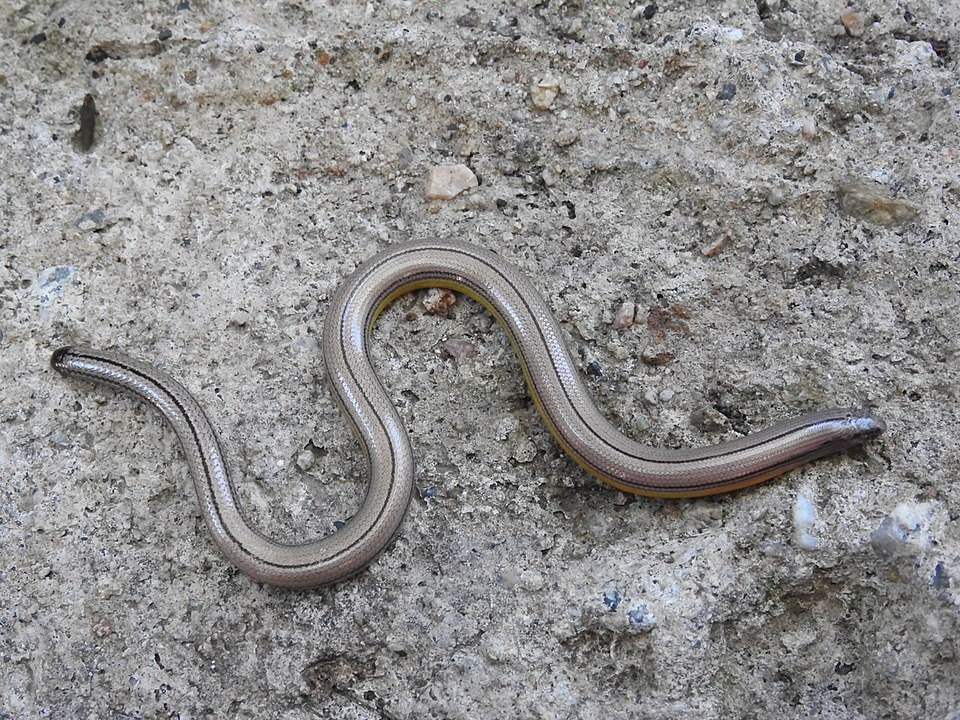In California, catching a glimpse of a lizard is a common occurrence, and you’re probably used to them now. But have you ever wondered how many lizard species exist in California?
Dozens of lizard species call The Golden State home and can be found everywhere, from city streets to the harsh desert.
In this article, we will be looking at a list of California lizards, exploring their habitats and food to learn more about them. In addition, we will give you a few fun facts about lizards and let you know if they’re an invasive species or not.
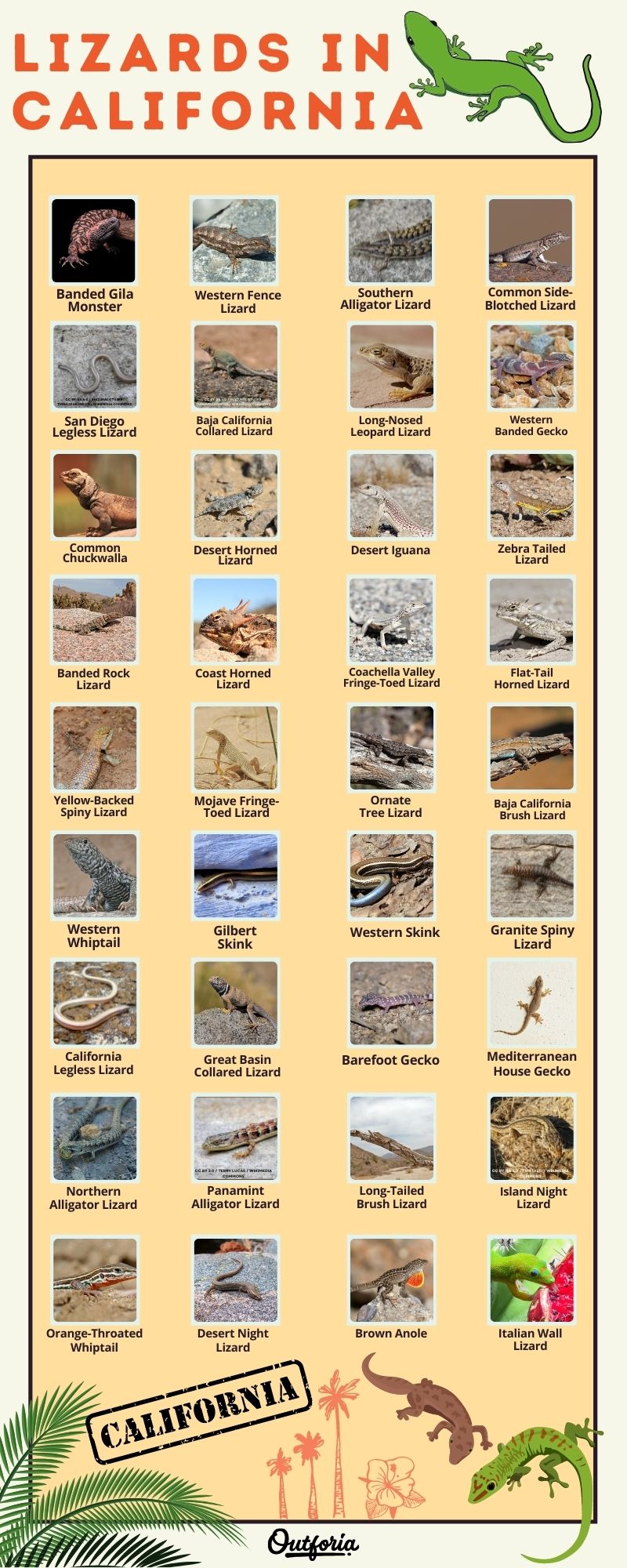
Share This Image On Your Site
<a href="https://outforia.com/lizards-in-california/"><img style="width:100%;" src="https://outforia.com/wp-content/uploads/2022/03/Lizards-in-California-infographics-03192022.jpg"></a><br>Lizards in Florida Infographic by <a href="https://outforia.com">Outforia</a>You May Also Like: This Is Everything You Need To Know About These 18 Common Types of Lizards in Florida with Photos, Chart, Guide, and more!
1. Banded Gila Monster
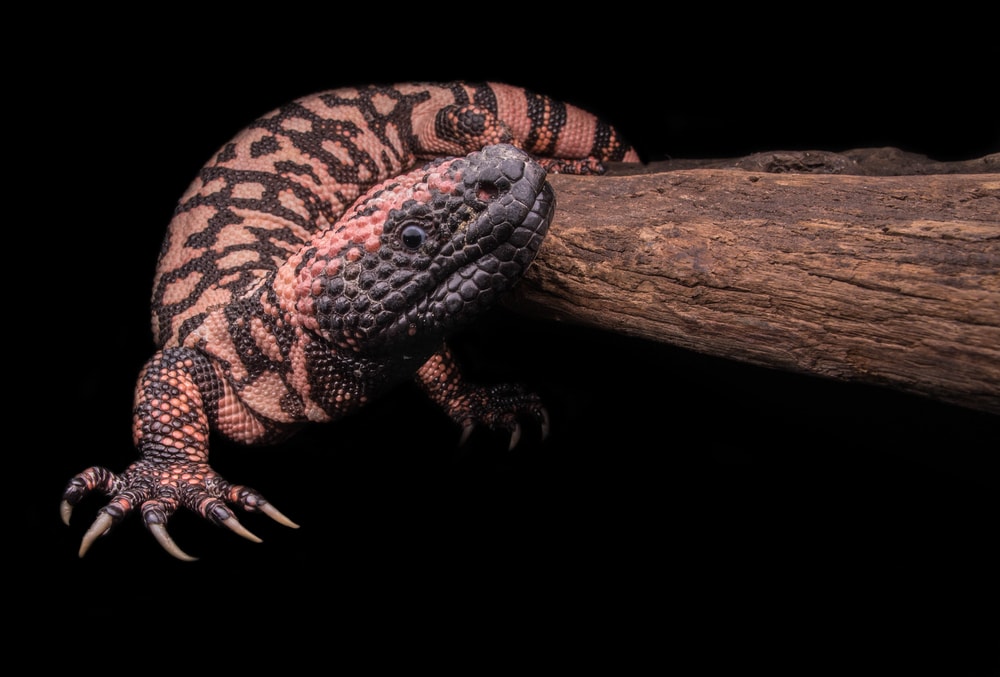
We start our list with the only lethal lizard living in California. The Banded Gila Monster is a rare lizard found in the California desert in the Southwest. It’s possibly the only poisonous lizard found in the entire United States. Its bite is quite painful, but there has not been a recorded death from a bite.
Banded Gila Monsters are carnivorous and feed on small animals, birds, bird eggs, and other small lizards. They are big in size and can grow to nine to fourteen inches. They belong to the H. Suspectum cinctum species have a lifespan of about 35 years in ideal conditions.
The banded Gila Monster lizard only emerges from hiding during dusk or dawn and after a rainstorm. They’re slow and tame and not likely to attack humans out of the blue. If you keep your distance, you will be fine. If you handle one, you need to have a professional with you or have the skills to hold one.
Humans hunt these lizards for their scaly skins and edible meat. Their skins are used to make high-end gloves.. Other than humans, they don’t have many natural enemies except for the occasional snake and coyote.
A fun fact about Banded Gila Monsters is that they are immune to their poison, and if two males fight, the other’s poison won’t affect them.
2. Western Fence Lizard
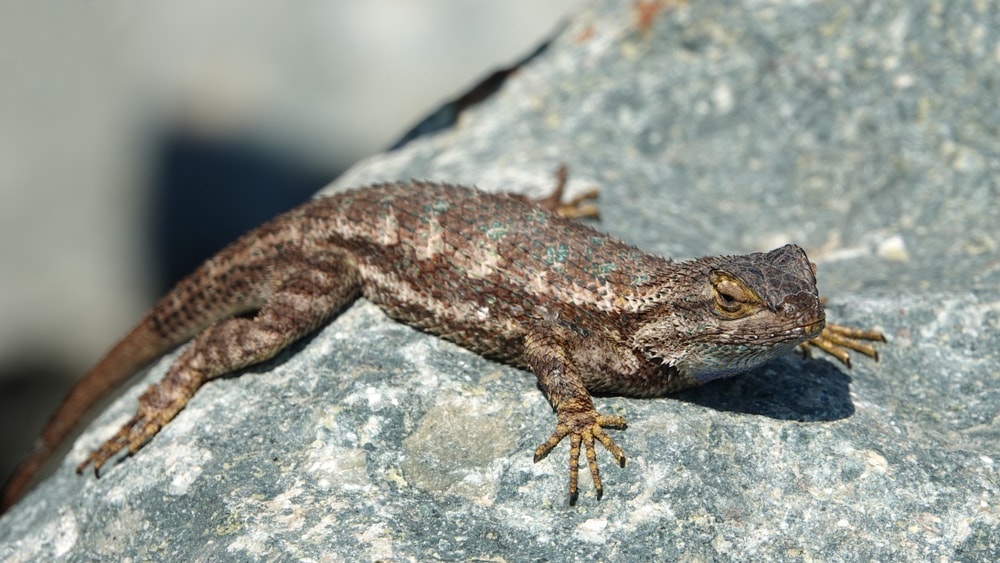
The Western Fence Lizard is the most common type of lizard found in California. They are found in a range of habitats, including farms and agricultural areas. You can even spot them in various other habitats, though they are known to avoid high elevations and extreme desert conditions.
They belong to the S. Occidentalis species and grow to about four to eight inches. They have a lifespan of about six years and feed on an insect diet. They are not the most colorful lizards with tan or brown scales.
Adult males are easily identifiable from their blue stomachs, which earned them the nickname “blue-belly lizard.” Look for patches of black on their belly and throat.
Even if they are not winning any pageant for best-looking lizards, they are legal to own as a pet. They like to bask in the sun on fences and hot surfaces during the day. This exposes them to predators such as birds, cats, and other predators. They are quick and possess fast reflexes, making them formidable opponents.
An interesting fact about Western Fence lizards is that they also feed on ticks. As you know, Lyme-disease-carrying ticks are dangerous to people and other pets. Research shows that there is a lesser occurrence of Lyme disease in areas Western Fence lizards exist.
3. Southern Alligator Lizard
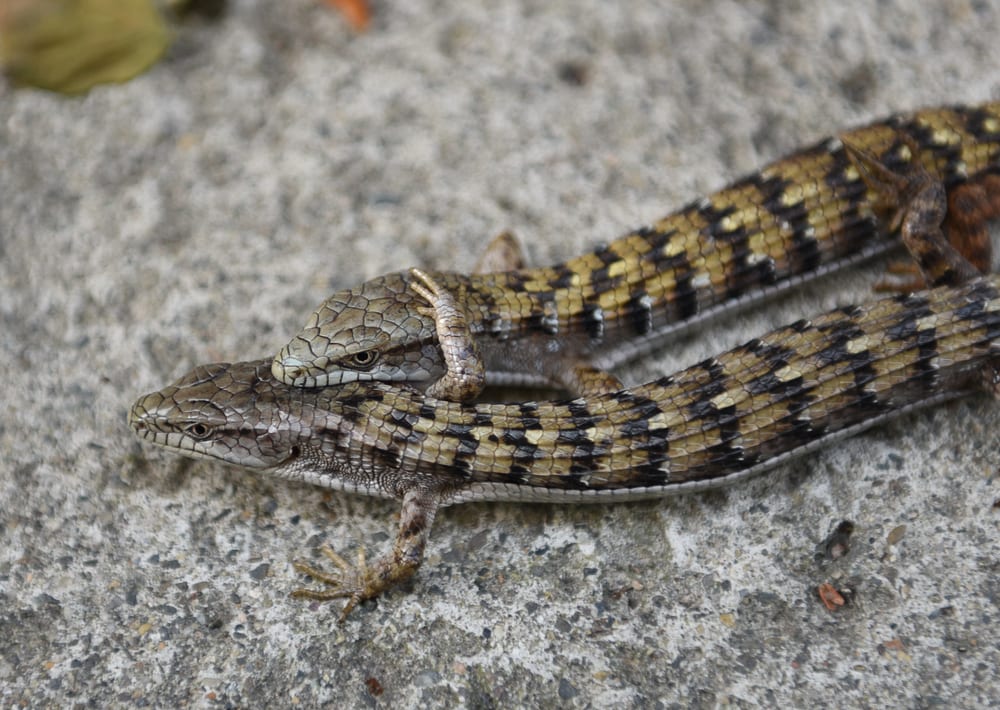
The Southern Alligator lizards come from the family of E. Multicarinata species. They are also quite common in California. Western Fence lizards outnumber Southern Alligator lizards in terms of numbers, but you’re still more likely to encounter one than a Western Fence lizard. Southern Alligator lizards are more adaptable to urban conditions than most lizards.
You will find them near areas with water, where they like to busk out in the sun. They feed on insects, Western Fence lizards, slugs and are even known to eat bird eggs. They grow to about three to seven inches when they reach adulthood. Their breeding season is in June or July, and they lay about 20 eggs that hatch in 55 days.
One interesting fact about reptile eggs and hatching is that the temperature during the incubation period determines the sex of the baby lizards.
Southern Alligator lizards have smooth scales and a head that resembles a snake’s head. They have pleasant colors and are very beautiful and are often considered as pets.
Southern Alligator lizards, like most lizards, can shed their tails when in danger and grow it back later. They are hunted by snakes, coyotes, cats, and hawks, but they are fast, agile and hard to catch.
Human settlements have encroached on most of their Californian natural habitat, but they have adapted well to urban settings.
4. Common Side-Blotched Lizard
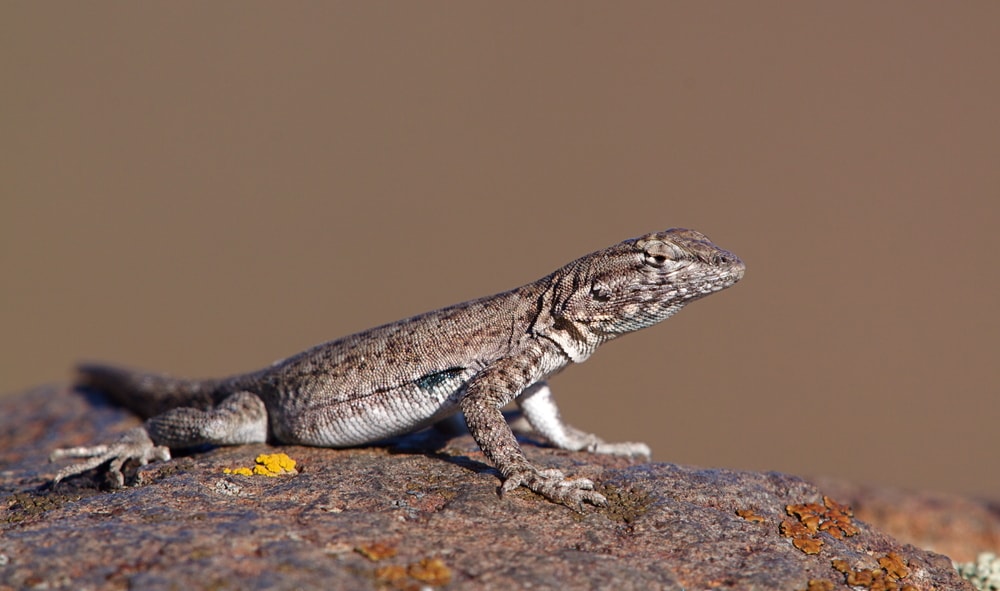
The Common Side-Blotched lizards belong to the U. Stansburiana of lizard species. They are small lizards that grow to about three to five inches and are most common in Southern California and Baja.
Adult males have a blue-gray blotch on either side of their bodies and a gray to tan bak. Females are predominantly plain brown and don’t have their male counterparts’ coloring. But all their undersides are light cream or pale gray.
An interesting fact about the Common Side-Blotched lizard males is that there are three “morphs.” Or three types of males. The orange-throated males that are dominant and possess a lot of females. The blue-throated males partner with one female.
You will mostly find them on the ground in sandy, bushy, and rocky environs where they like to spend most of their time.
They feed on beetles, ants, scorpions, and other small insects. Females lay eggs in clutches of three or five in June.
Common Side-Blotched lizards have no known enemies and are one of the species that are considered “no concern” due to their established populations..
5. San Diego Legless Lizard
The San Diego Legless lizard belongs to the A. Stebbinsi species. As their name suggests, they are a legless species commonly found in Southern California near San Diego. However, you can still find them near the coast in almost identical numbers.
They are listed as lizards and not as snakes because they have eyelids. Snakes don’t possess eyelids.
They grow to about 7-8 inches (18-20cm) long and have a life expectancy of 20 years. They like to burrow in loose soils and sands where they feed and spend most of their time. They eat bugs, spiders, termites, and other insects. The San Diego Legless lizards are hunted by snakes, cats, mice, and birds. Because of their lack of legs, they are pretty defenseless and prefer to remain in hiding.
6. Baja California Collared Lizard
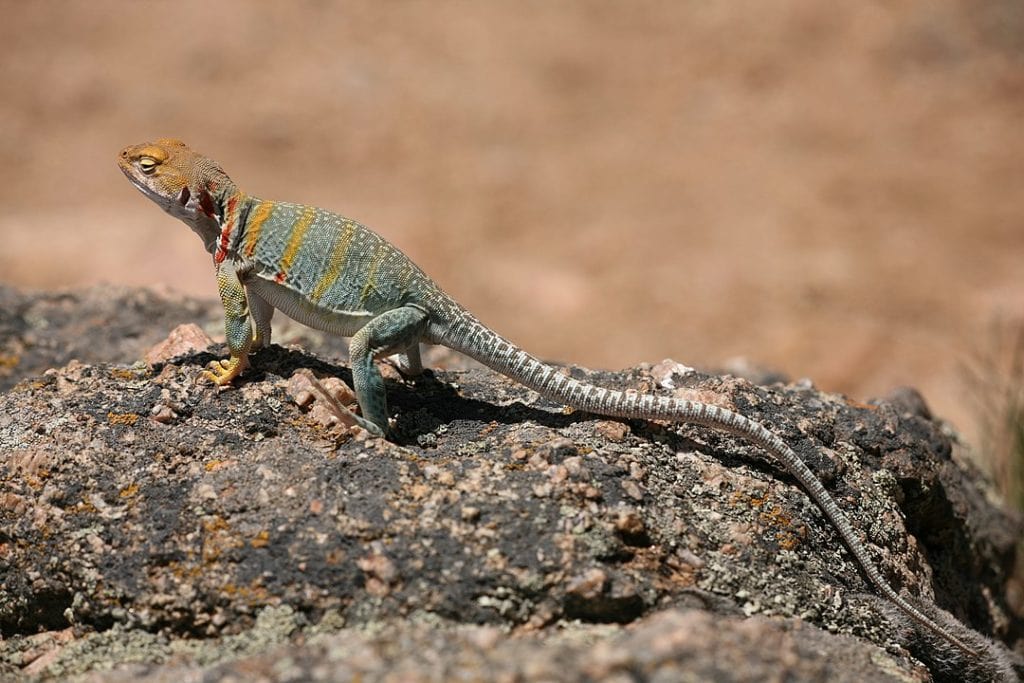
The Baja California Collared lizard is part of the C. Vestigium species. Found in the Baja region of California, these lizard species like rocky, arid areas. Due to this, most people will go a lifetime without ever laying eyes on one.
They are small in size, only grow to about 2-4 inches (5-10cm), and have a life expectancy of eight years. The adult males have vivid greenish and tan, bluish scales. On the other hand, females have more dull colors, but both possess a creamy underbelly.
They are known as California Collared because they have two black collar strips on their necks.
The Baja California Collared lizards are one of the few lizard species able to walk on their hind legs. They do not lose their tails easily because they do not grow them back once they break off.
They live in rocky deserts or open desert foliage. They feed on grasshoppers, crickets, and other lizards, including Baja California Collared lizards. Their natural predators include other lizards, cats, birds, and coyotes. They have as much to fear from other lizards as other lizards do from them.
An interesting fact about Baja California Collared lizards is that females’ bodies turn patches of red when they are carrying eggs. The colors return to their usual patterns after they lay the eggs.
7. Long-Nosed Leopard Lizard
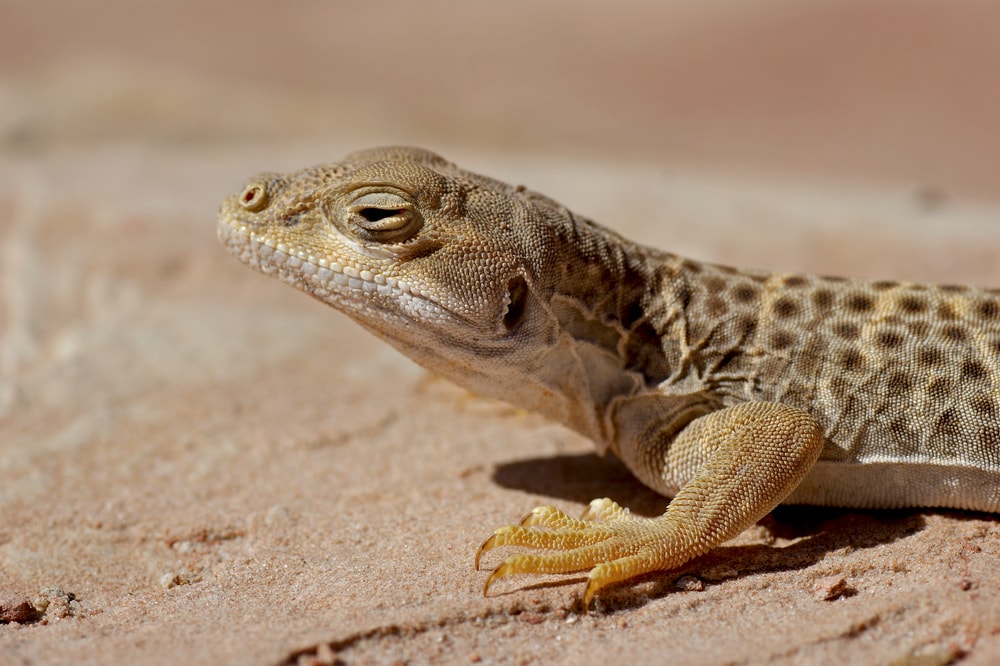
The Long-Nosed Leopard lizard belongs to the G. Swilizenii species. You will find them in some parts of Baja, California. In the leopard family of lizards, the Long-nose is the only species not endangered.
They can grow to about 3-5 inches (8-12 cm) and have a life expectancy of seven years. Like the cat they share a name with, Long-Nosed Leopard lizards also have spots. One of the easiest ways to identify them is by looking at their spot patterns.
Females get orange spots all over their bodies during the breeding season. The spot patterns disappear once they lay their eggs.
In addition, the lizards also share the ambush tactic of hunting with the leopard. They lie still and wait to surprise their prey in arid bushes and shrubs camouflaged by their pattern of spots. But unlike leopards in the African savanna, Long-Nosed Leopard lizards can change color and subsist on an omnivorous diet.
They feed on beetles, grasshoppers, bees, small snakes, soft leaves, and berries. The Long-nosed Leopard lizards are legal to own as pets and probably one of the easiest to feed.
They like flat gravel lots where they can catch a lot of sunlight and accessible prey.
8. Western Banded Gecko
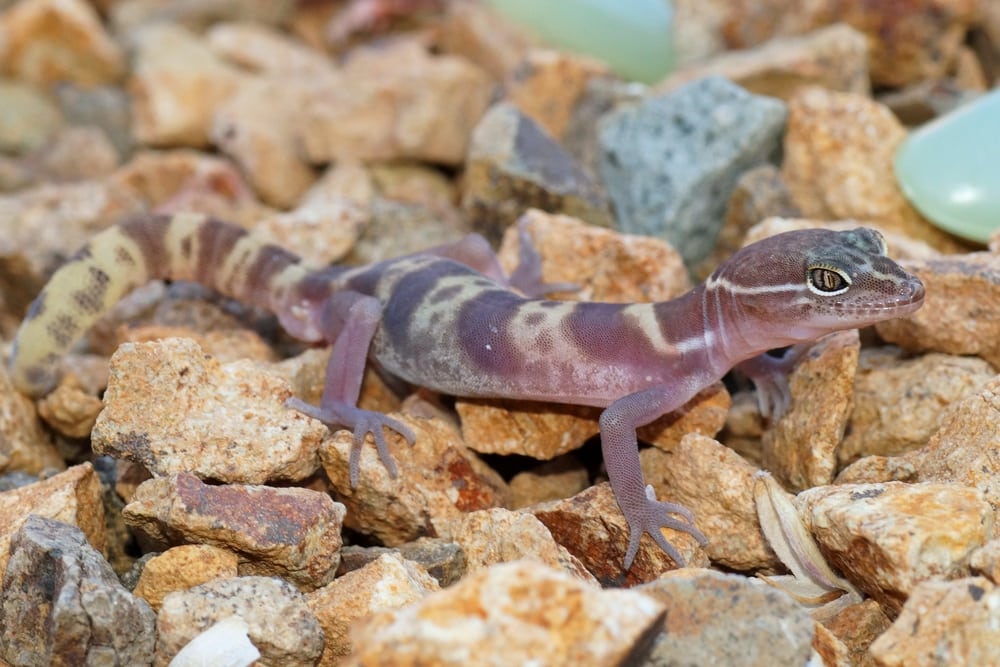
The Western Banded Gecko is part of the C. Variegatus species. Found in the desert regions of California, they are primarily arid habitat dwellers. In addition, they are also well adapted to urban, rocky, and sandy places.
They grow to be about 4-6 inches (10-15cm) big and have about 8 years of life expectancy. They are pink to light yellow and have brown stripes down their back. Their underbelly is white and almost translucent.
Their pupils are vertical, and they can move their eyelids. And as we learned earlier, it’s an essential distinction between snakes and lizards.
Western Banded Geckos are well adapted to climbing vertical surfaces such as walls and rocks where they like to hang out. You can also find them using debris as cover and can withstand hot temperatures and a lack of rain for long periods.
Western Banded Geckos are highly sought-after as pets, but they are illegal to sell in all states except Nevada. If you can snag one, consider yourself extremely lucky and enjoy your time with the lovely creature.
The Gecko’s favorite snack in the wild is the scorpion, spiders, and insects. Many compare its stance to that of a scorpion while hunting because it likes to wrap its tail around its prey.
Their natural predators are snakes, birds, cats, and coyotes. The Western Banded Gecko makes a swift escape when threatened by losing its tail and leaving it behind as a distraction. It also lets out a loud squeaking noise when mishandled.
9. Common Chuckwalla
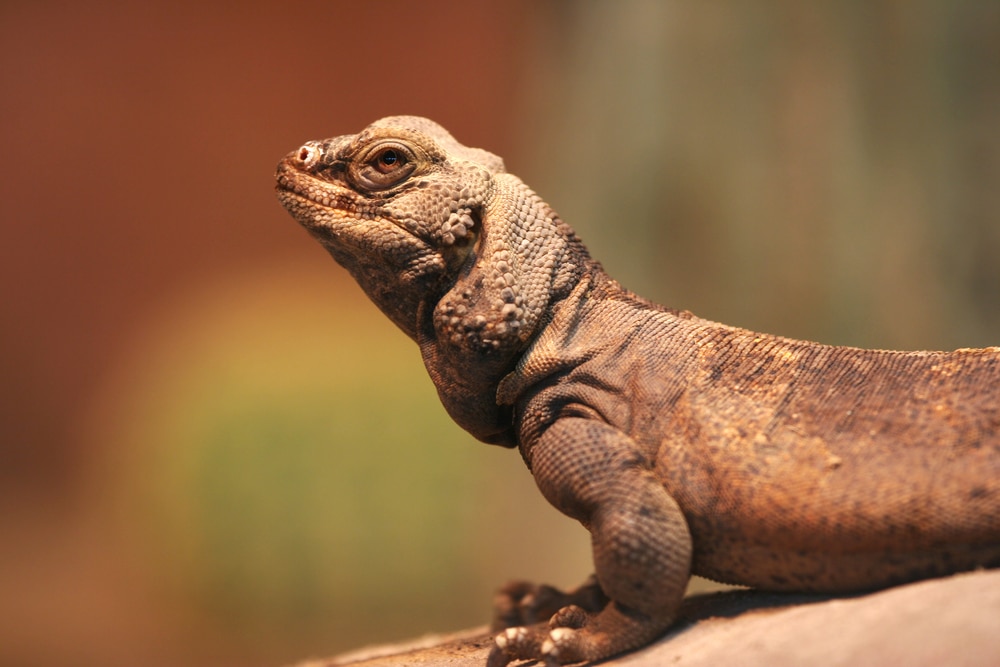
Common Chuckwallas are part of the S. Ater species. One of the largest lizard species in California, they can be found in the Sonoran and Mojave deserts. And unlike most lizards, they remain active throughout the year and during the day.
They grow to about 15 to 20 inches (38-50 cm) . These lizards are enormous and have a life expectancy of about 25 years. A true testament to how long a lizard can live with some TLC. Speaking of care, they like hot temperatures and like to busk out in the sun. In fact, these lizards like the heat so much that if they had the option to live on lava, we think they would.
You can also spot them basking in the sun on the sides of the roads or pavements.
Their colors vary between sexes and the age of the lizard, but males have a black head, chest, and limbs. Their backs are reddish, blackish to a grayish hue.
Common Chuckwallas’ are also flat, and huge folds of dangling skin hang from the sides of their necks. They are thought to mark their territories using excretion from pores on the sides of their mouths. These lizards might look aggressive, but the following fact will shock you.
They are herbivores. Yes, that’s right. These huge behemoths feed on vegetation, mostly on annual and perennial plants, with the occasional insect here and there. This also makes them excellent pets, and for their aggressive looks, they are pretty gentle creatures and fun to have around.
Female Chuckwallas lay about six eggs in the summer, and the baby lizards hatch in September.
Common Chuckwallas are hunted by rattlesnakes, coyotes, and kestrels. When threatened, they hide in small crevices between rocks and inflate their bodies with air to wedge themselves in the rocks.
10. Desert Horned Lizard
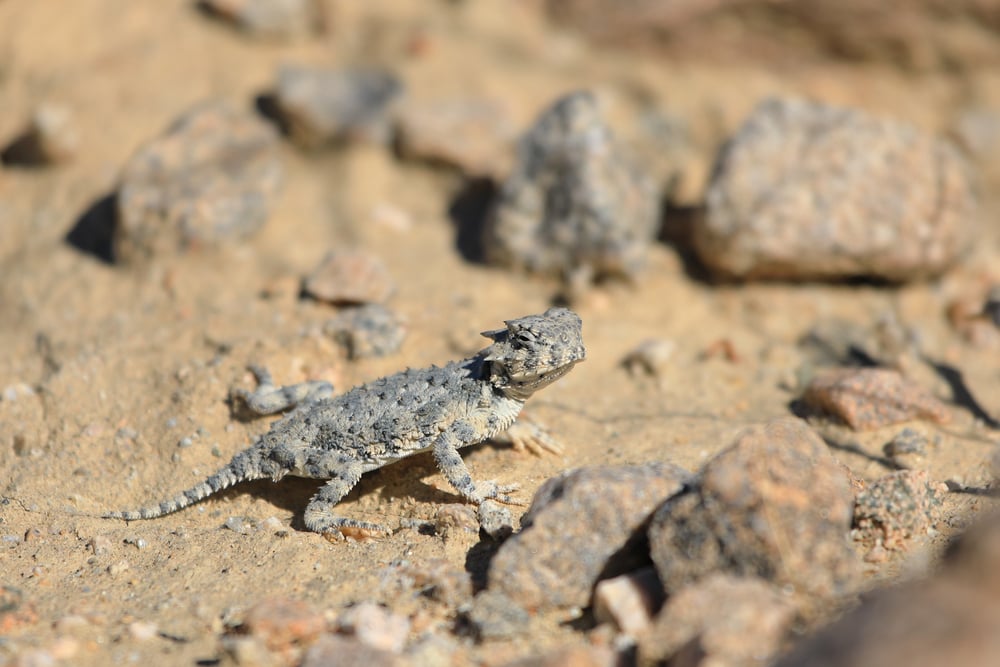
Desert Horned Lizards are part of the Platyrhions species. They are found in Northern California in forest clearings and sagebrush deserts. One defining feature of these lizards is that they squirt blood from their eyes to confuse predators.
They grow to about 2-4 inches (5-10cm) and have about eight years of life expectancy.
Desert Horned lizards are also defined by their big, pointed scales and a horn that sticks out at the back of their heads. Most are either brown, red, tan, grey, or black. They also have a wavy pattern of spots on their backs and heads.
They dance during the mating season to impress mates by bobbing their heads, moving their bodies, and waving their tails.
Desert Horned lizards eat food that ranges from ants, insects, and other small incrustations. On the other hand, they are hunted by cats, snakes, coyotes, and hawks.
11. Desert Iguana
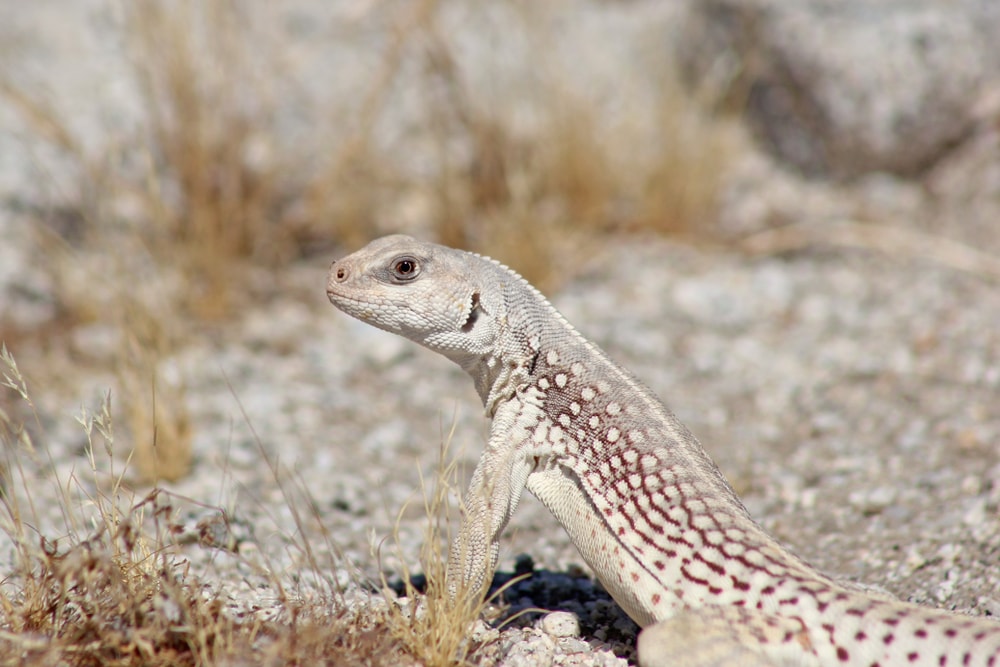
Desert Iguanas are part of the Dipsosaurus Dorsalis species. They are found in the East-Central regions of California. They are also found in the Mojave and Sonoran desert. They inhabit areas with creosote brush, but they live on rocks or scrubland where the plant is scarce.
They grow to be about 16 to 18 inches (40-45cm) and have a lifespan of about eight to ten years. They have a rounded body, a small head, and a long tail. They are pale grey and have rows of grey spots. Their underbodies turn to a pinkish-red during the mating season.
Desert Iguanas like to bask in the heat even during the noon sun and only seek shade once their bodies reach 113 degrees Fahrenheit. This is because, like most reptiles, they rely on the sun to regulate metabolism. They store excess heat energy in their scales and warm their blood during cold nights to stay active.
Desert Iguanas are omnivorous and eat leaves, flowers, and buds from the creosote bush. They also feed on insects and carrion to balance their diets. They don’t drink a lot of water as the moisture from the food they eat is sufficient.
Their natural predators are foxes, raptors, and snakes but desert iguanas are very agile and can be hard to catch.
Desert Iguanas are also considered excellent pets.
12. Zebra Tailed Lizard
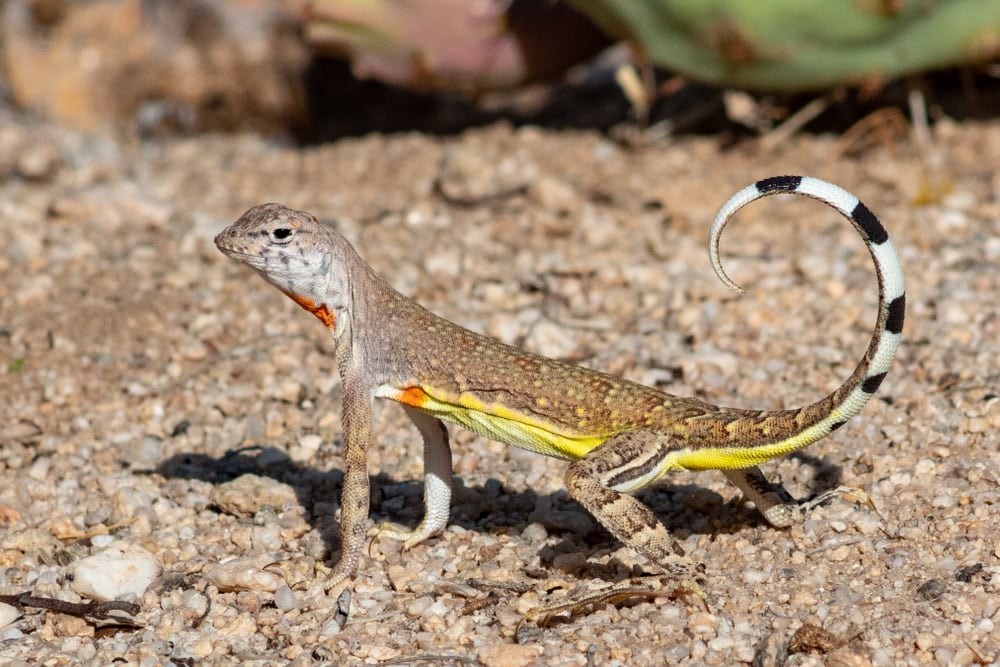
The Zebra Tailed lizard belongs to the Callisaurus draconides species. It is found in the Mojave desert in Southeastern California. They are well adapted to arid dry conditions.
They grow to about 2-4 inches (5-10cm) and have a life expectancy of four years.
Zebra Tailed lizards have distinctive pattern spots on their under tails that resemble zebra markings. Hence their name.
They possess long limbs that help them run fast and are one of the fastest lizards on our list. When approached by predators, they lift their tails to reveal the pattern. They then sprint, stop and drop their tails to hide the pattern. This confuses the predators and helps them evade capture. Other than the markings on their tails, they are mostly black and white. They also have a yellow-orangey tint on their sides that helps them blend well with rocks and sand.
They feed on small invertebrates, other small lizards, and some vegetation.
13. Banded Rock Lizard
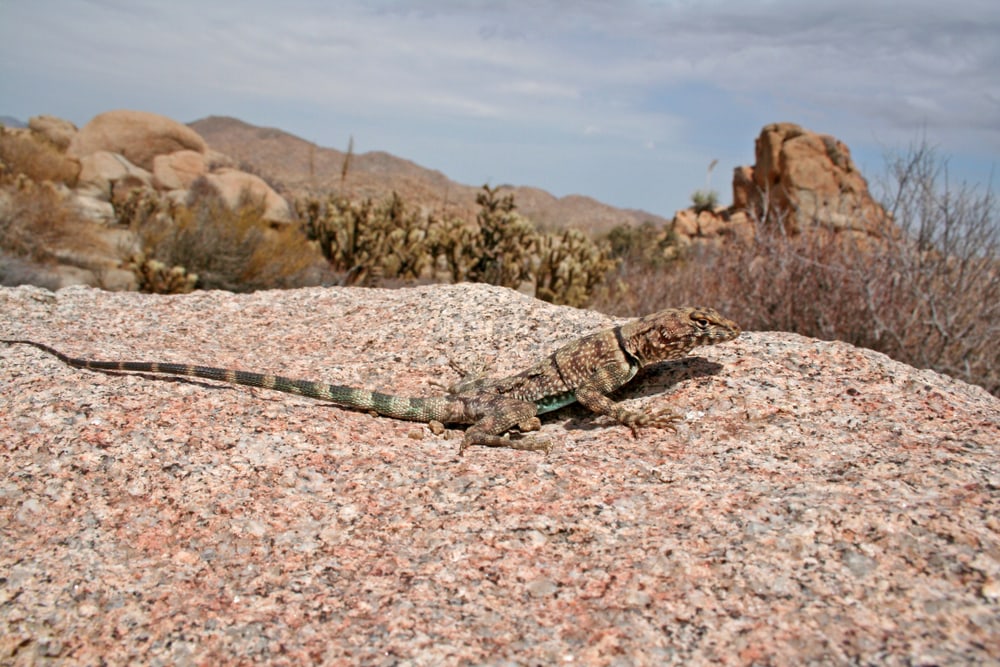
The Banded Rock lizards are part of the Petrosaurus Mearnsi found in Southern California and the Baja desert. They like to live in rocky habitats and terrain and are the best rock climbers in the lizard class.
They grow to about 3-5 inches (8-12cm) long and have about nine years of life expectancy.
Banded Rock lizards have flat bodies, big limbs, and a huge head for a lizard. Their spiny scales are arranged in rows and olive, brown, or greyish-blue hue. The colors turn to refined bands as you get to the tail of the lizard. The males’ color spots on their backs change as they get close to the females.
When the females are heavy with eggs, an orange color appears around their eyes and throat. The color does disappear once the lizard lays its eggs.
Even though you might go a lifetime without ever laying your eyes on one, the Banded Rock lizard observation status is least concerning. If you plan on keeping one as a pet, you should know they can bite when handled.
14. Coast Horned Lizard
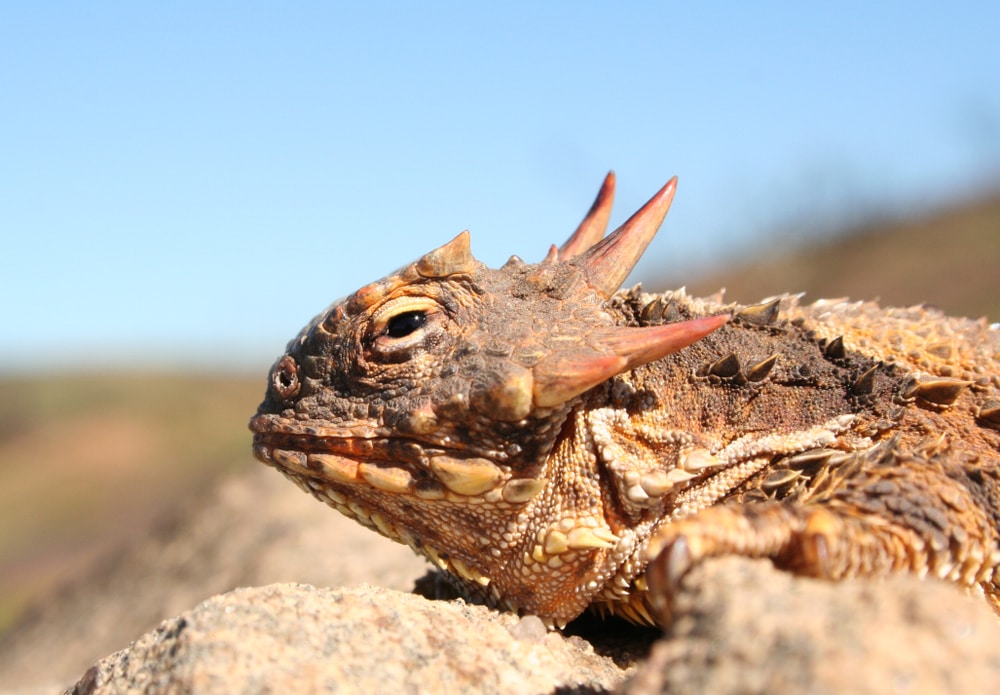
The Coast Horned lizard is part of the Phrynosoma Blainvillii. This is one lizard species endemic to California. They are found in the Baja desert. You can also spot them in the South and central coastal ranges.
They grow to about 2-4 to four inches (5-10cm) and have a life expectancy of about five years and are considered a threatened species.
The Coast Horned lizards have two rows of pointed scales lining their backs and long horns at the back of their heads. They are yellowish to brownish or reddish with grey wavy lines.
They’re also another species that squirt blood through a pore near their eyes as a defensive mechanism. This is aimed at confusing their predators and buying them time to escape. One more defensive tactic they employ is the use of their horns. When snakes try and swallow them, they get lodged in their mouths and may even lead to the death of both reptiles.
The Coast Horned lizards like open areas with a lot of sunshine to busk in and loose soil or sand to burrow in. They feed on ants, spiders, and beetles. Their natural enemies are cats, snakes, hawks, and coyotes.
15. Coachella Valley Fringe-Toed Lizard
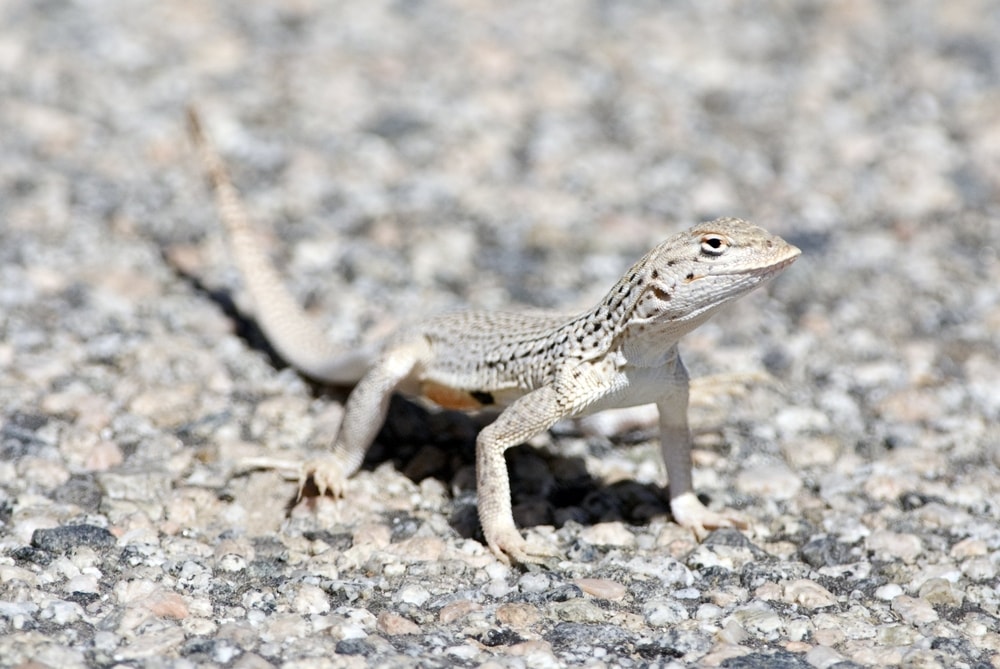
The Coachella Valley Fringe-Toed lizards belong to the Uma Inornata species in Southern California. The Desert Horned lizard might have moves like Jagger, but the Coachella Valley Fringe-Toed lizard knows how to throw a party.
The lizards grow to about 10 inches (25cm) and have about 6 years of life expectancy. Their natural habitat is an arid area with little vegetation and soft, loose sand for easy burrowing.
They are white with pattern spots that look like lines running the length of their body. The pattern acts like camouflage and helps the lizards to blend well with their sandy dwellings.
The underside of the lizard body is pale, and the tail has black lines.
During the mating season, the males’ side bellies turn pinkish and reddish around their eyes. In contrast, females heavy with eggs turn orange on their flanks, faces, and parts of their tails.
The Coachella Valley-Fringe Toed lizard hibernates in November and emerges back in February. It digs a burrow in the sand and stays there for the duration.
The lizards are omnivorous and feed on various plants, flowers, leaves, insects, and even hatchling lizards. Weirdly enough, they consume their own skin after shedding it and even eat the skin of other lizards if they come across any.
They are hunted by cats, coyotes, snakes, and hawks. These lizards are currently endangered.
16. Flat-Tail Horned Lizard
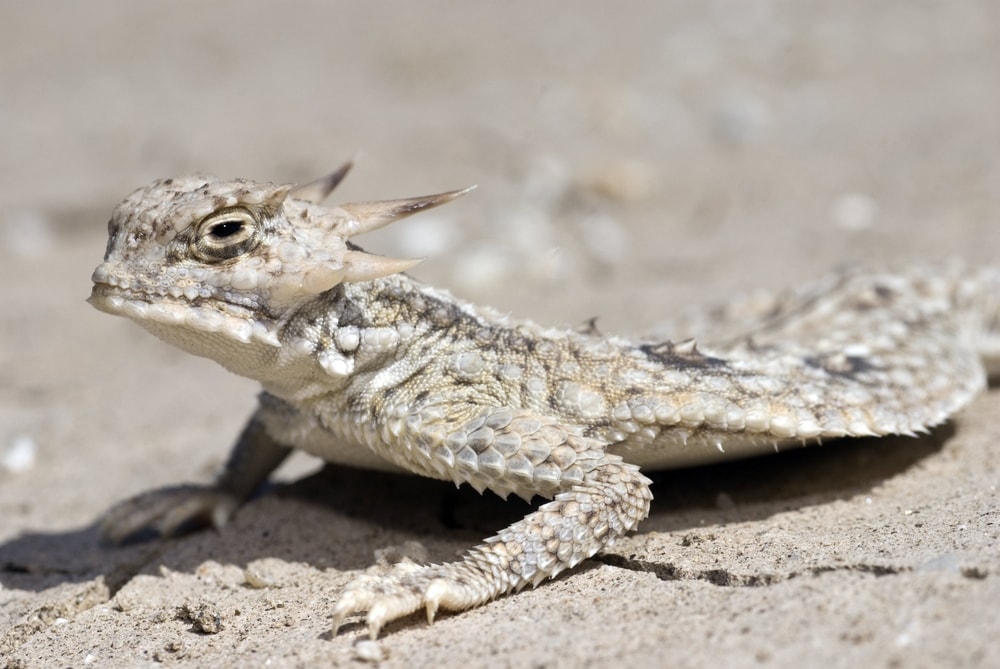
The Flat-Tail Horned lizards are part of the Phrynosomatidae species, also called “horny toads.” Found in South and Central coastal ranges and the Sierran foothills.
They grow to about 2.2 to 3.4 inches (6-11cm)and have about 5 years of life expectancy. They are grey or brown, depending on the color of the soil where they live.
The Flat-Tail Horned lizard is a master at camouflage, and you might have walked past a few. You just didn’t see them. They blend well with the vegetation around or partially bury themselves in the sand to avoid detection.
This is the most endangered species of all the horned lizards in California. They have also lost most of their habitats to human activity, such as road geothermal power plants. Conservation efforts are ongoing, and we hope their numbers increase soon.
Adult Flat-Tail Horned lizards hibernate during the winter, but young ones stay active even in the cold.
They feed on harvester ants found in the same habitats they like to live in and supplement their diets with other smaller insects.
17. Yellow-Backed Spiny Lizard
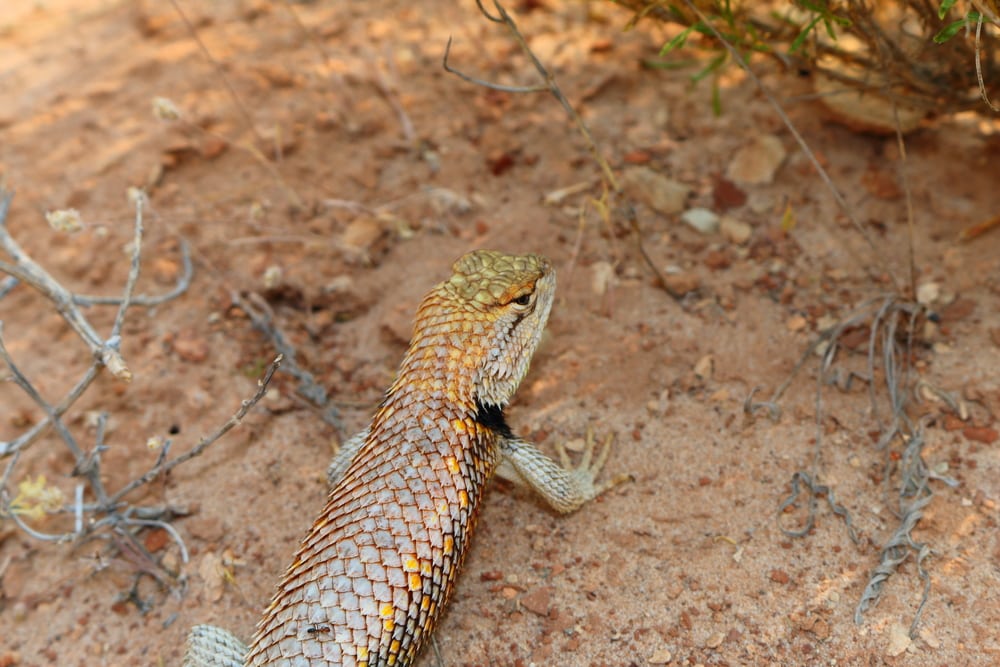
The Yellow-Backed Spiny lizard is part of the S. Uniformis species. Found in the Great Basin desert, the Mojave desert, and the South Coastal ranges of California. They are robust and well-built lizards with pointed scales.
They can grow to about 4.4 to 5.5 inches (11-15cm) and have about 4 years of life expectancy. They are either brown or tan and have distinctive markings on the dorsal. They also have a black wedge mark on their necks.
On the underside, the base of the males’ tail, where it connects with the rest of the body, looks like it’s swollen or more enlarged than on females. Males also have blue patches on their stomachs and the side of their necks.
The female’s underbelly is pale, and their heads turn orange during the breeding season.
The Yellow-Backed Spiny lizards are active from April to October and seek shelter in excess heat or cold seasons. They spend a lot of time on the ground looking for food, but they are also good climbers.
They shelter mostly under rocks, logs, or burrow cavities under loose sand. The lizards reach sexual maturity in two years, and mating occurs in summer. Females lay about three to nineteen eggs, and young ones appear three to four months after.
They feed on leaves, flowers, spiders, ants, and larvae. Their natural enemies are snakes, cats, coyotes, and hawks. However, the lizards are pretty fast on their legs and sprint into hiding in the sight of danger. As an added precaution, their tails break off and wiggle around as a distraction.
18. Mojave Fringe-Toed Lizard
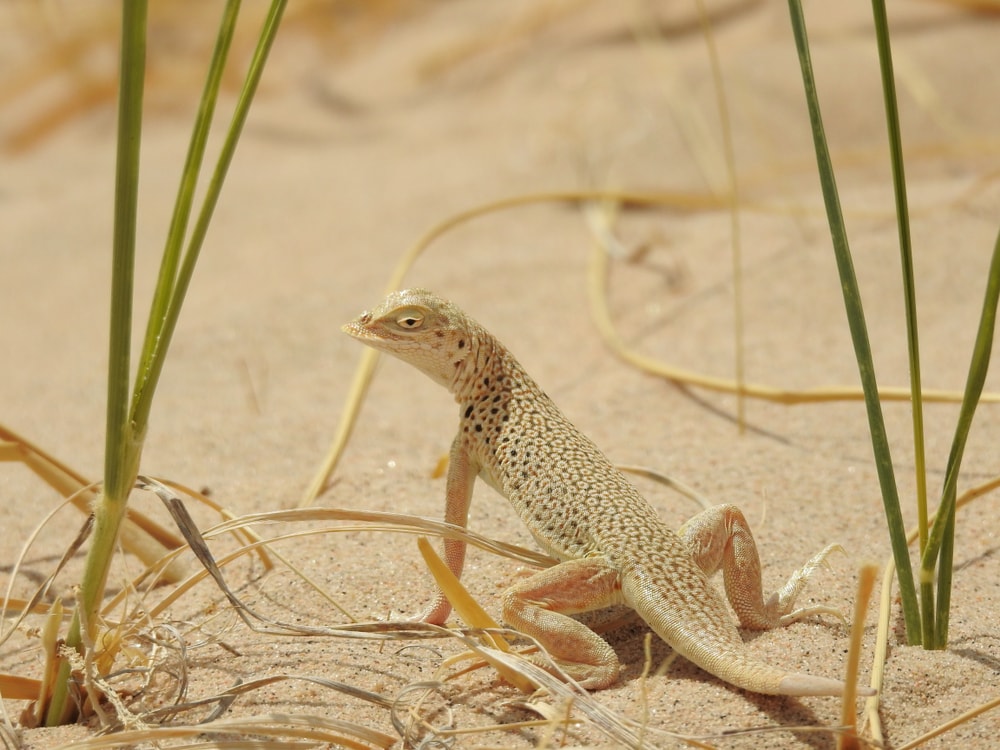
The Mojave Fringe-Toed lizards belong to the U. Scoparia species. Found in the dunes of the Mojave desert in California, hence their name. The other part of their name pays homage to how their fringed toes keep them from sinking into the sand as they run. A testament to how scientists are bad at naming stuff.
The Mojave Fringe-Toed lizards grow to about 2.75 to 4.2 inches (7-11cm) and have a 6 year life expectancy.
They are flat-bodied, smooth-skinned lizards that like hot sandy regions. They are white or grey, with blotches of black patches on their backs. The underbody is pale and has black lines running through the tail.
A distinctive crescent-shaped line on the throat helps to set this species of lizard apart from other fringe-toed lizards in California.
Male lizards have two postanal scales that are more enlarged than in females. During the breeding season, males turn pale green on their bellies and pinkish on the sides. Females turn to bright pink on their sides.
The Mojave Fringe-Toed lizards are diurnal, which means they are only active during the day. They live in habitats with fine sand blown by the wind. This makes it easy for them to burrow down and take shelter from the hot sun or sleep at night.
The species of lizards also hibernate in the cold season. In November, it goes underground and comes out of its deep slumber in February. Though, young adult lizards don’t always go into hibernation and instead brave the weather.
An interesting fact about the lizards is that they can tell how much radiation they have received through their parietal eyes. These are their unofficial thermometers on the top of their heads that help them not get too much or too little solar heat.
The lizards feed on seeds, blossoms, grasshoppers, ants, and beetles. Their natural predators are coyotes, cats, snakes, and hawks.
These beautiful lizards are legal to own as pets and make for great companions.
19. Ornate Tree Lizard
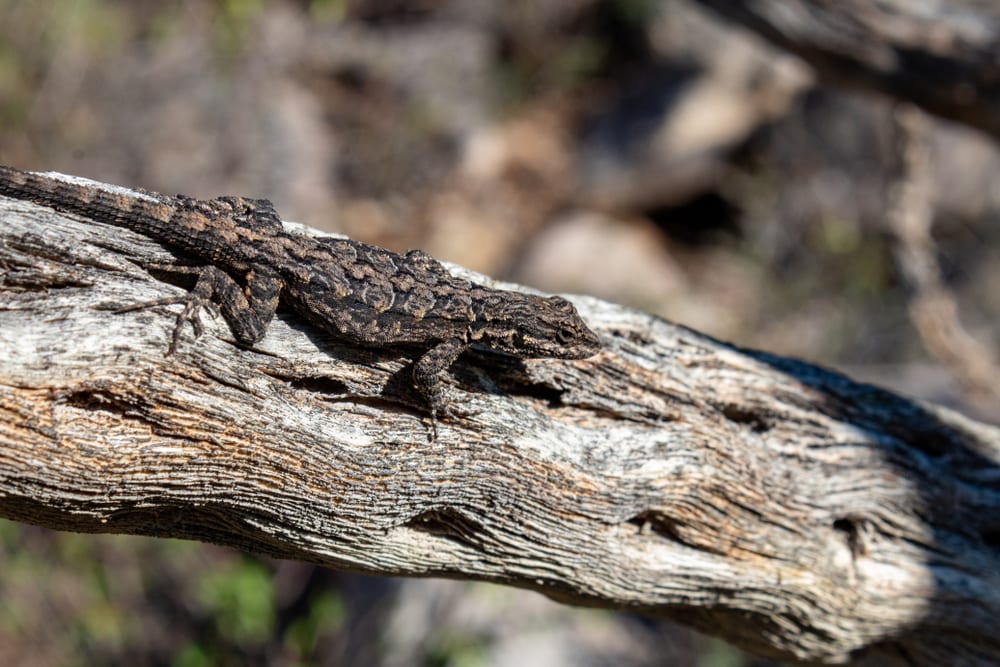
The Ornate Tree lizards are part of the U. Ornatus species. Found in the banks of the Colorado River in Imperial County, California. These lizards are well adapted to arid, urban, and agricultural areas.
They grow to about 1.5 to 2.5 inches (4-6cm) and rarely live longer than three years. One of the shortest life spans in the Californian lizard species.
They have a distinctive scale pattern with a dual-line of enlarged scales running down their backs separated by more minor granular scales.
The lizards are a brown, tan, or grey hue with irregular black bars spotted on their backs. They seem to match well with their surroundings for better camouflage.
Males have throat patches that can either be blue, yellow, or orange. They also have green spots on their underbelly and huge postanal pores.
On the other hand, females tend to have orange or yellow throats and pale underbellies.
Despite being called the tree lizard, the Ornate tree lizard spends most of its days parched on rocks. It is even common to find them in areas with no trees, but to their credit, they climb trees to find food or escape danger.
They are also very well adapted to urban areas, and their numbers are steadily growing in Californian cities and towns.
They are a hibernating species and are only active in the year’s warmer seasons.
Ornate Tree lizards feed on flies, ants, beetles, and spiders. They avoid cats, snakes, birds, and other larger lizards. However, they possess good reflexes and are quick on their feet. Their tails break off as an added defensive advantage. The tails grow back over time.
20. Baja California Brush Lizard
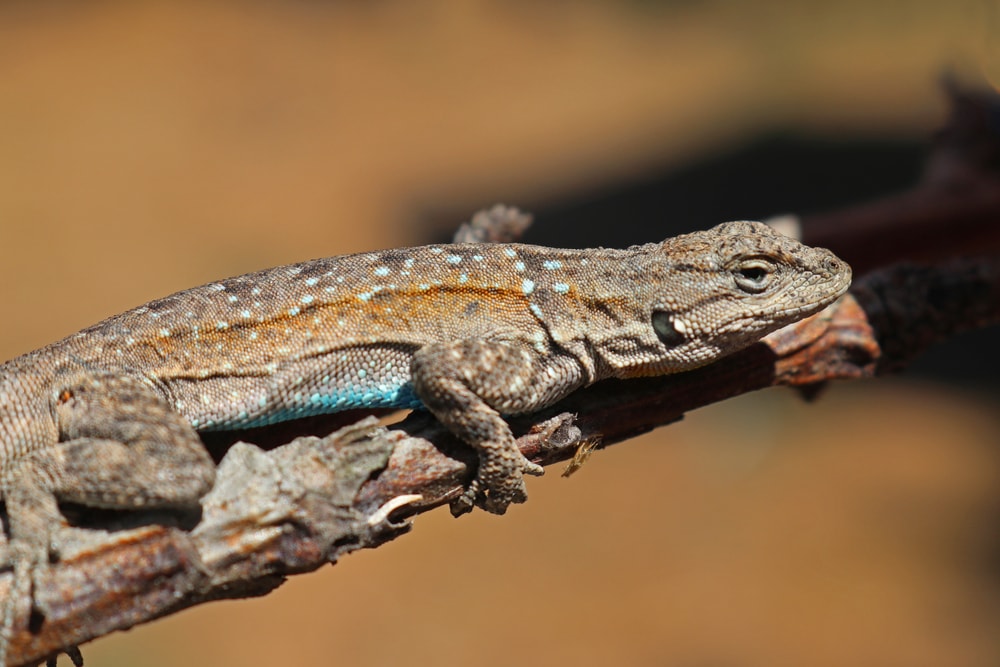
The Baja California Brush lizards are part of the U. Nigricauda species and are found in the Baja desert in California. They are small lizards with long thin tails.
They grow to about 1.5 to 2 inches (4-6cm) long and have a 6-year life expectancy.
Their scales are small and have a strip of large keeled scales on their backs. The upper part of their necks folds along their throats and continues to the sides of their bodies. And the scales on their tails are keeled as well.
The Baja California Brush lizards are brown or grey and have blotches of black lines on their backs. Some lizards even have strips of white color on the sides of their bodies.
Males tend to have black tails that, in some cases, are covered in rust or a yellowish, brownish hue. Their underbelly is usually blue with hints of yellowish-green on the necks of males and a pale white on the females.
Males are territorial and generally try to keep other males out of their areas. In addition, they try to attract female lizards by using bravado. They bob their heads in dance and do push-ups to prove their grit. If that doesn’t impress the ladies, they lift their heads to reveal their beautifully colored necks.
The Baja California Brush lizards are good climbers and scale everything from trees to boulders. They are also fast on their feet and prove formidable to any animal trying to catch them.
They hibernate in groups in the winter and are active during the other seasons.
The lizards feed on small bugs, spiders, and ants. They are also hunted by cats, snakes, and birds.
21. Western Whiptail
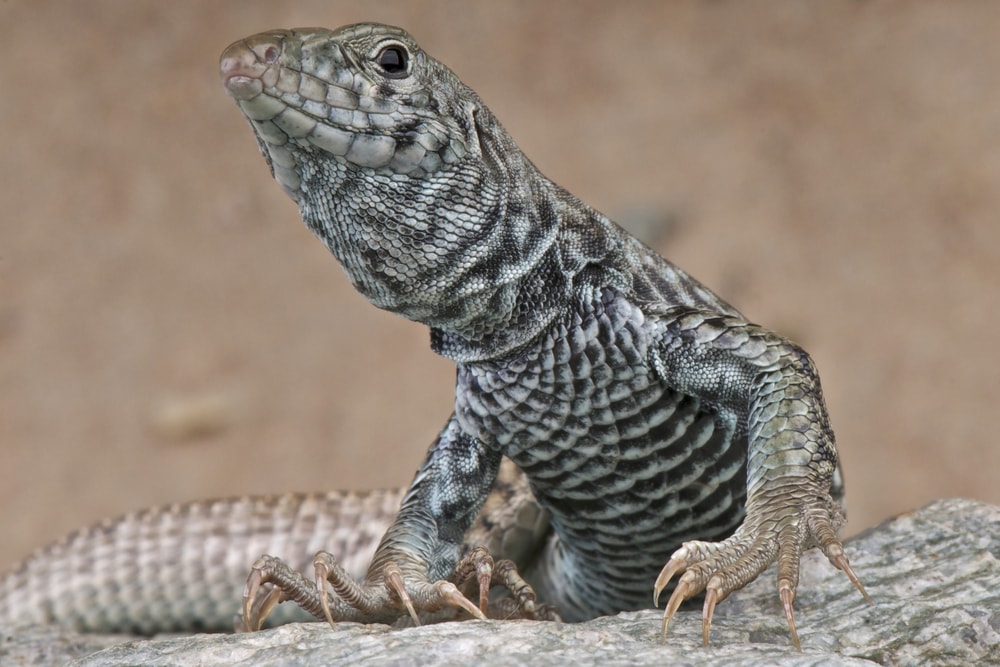
The Western Whiptails are part of the A. Tigris species. Endemic to California, you can find them in the Central Valley, Monterey Bay, and Southern California in Ventura county.
They grow to about 2.5 to 5 inches (6-12 cm) long and have 3.5 years of life expectancy. Unlike other species of whiptails with all females, this species has both males and females.
They have a pointed snout, a long slender tail, and a slim body. The scales on their backs are granular, and the ones on their tails are keeled. Interestingly enough, the scales on their bellies are arranged in rows of eight, rectangular and rustic-looking.
Their grey-brown to yellow hue form a web-like pattern on their backs that is pleasing to look at. Their necks have folds that make them look jointed.
The tails of young Western Whiptails start out as blue but have well-defined strips by the time they are juveniles. The lizards are wary by nature and move around a lot. They like to stick their tongues out and dig for insects when foraging.
They feed on spiders, scorpions, centipedes, and other small invertebrates. Their natural predators are bobcats, hawks, foxes, and larger lizards.
22. Gilbert Skink
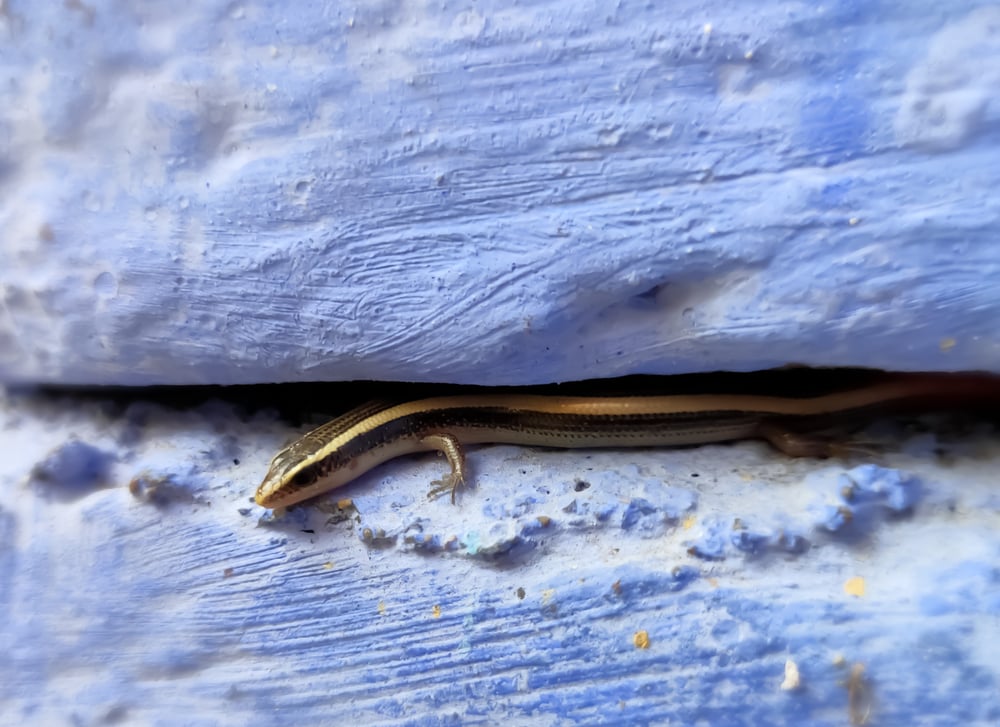
The Gilbert Skinks are part of the P. Gilberti species. Found in the Northern San Joaquin Valley and on the coast of San Francisco Bay. You can also spot them in the Sierra Nevada foothills.
They grow to be about 2.5 to 4.5 inches (6-11cm) and have a 6-year life span. Interestingly, their tails can grow to twice the size of their bodies.
Gilbert Skinks have small heads, large bodies, smooth and shiny scales that are cycloid, and tiny legs.
They have an olive to a brownish hue. They also have light strips of darkey scales running down their bodies.
Gilbert Skinks are good burrowers, and you will see them moving on the ground. They also like to seek shelter under objects on the ground. They are also very adaptable to different environments and can be found in various habitats.
They are ready to reproduce by year two, and females lay three to nine eggs in the summer. There are three known subspecies of the Gilbert Skinks:
- The Great Brown Skinks
- The Northern Brown Skinks
- The Variegated Skinks
- The Western Red-Tailed Skinks
The Gilbert Skinks are also known for dropping their tails when freezing from enemies as a defensive behavior.
23. Western Skink
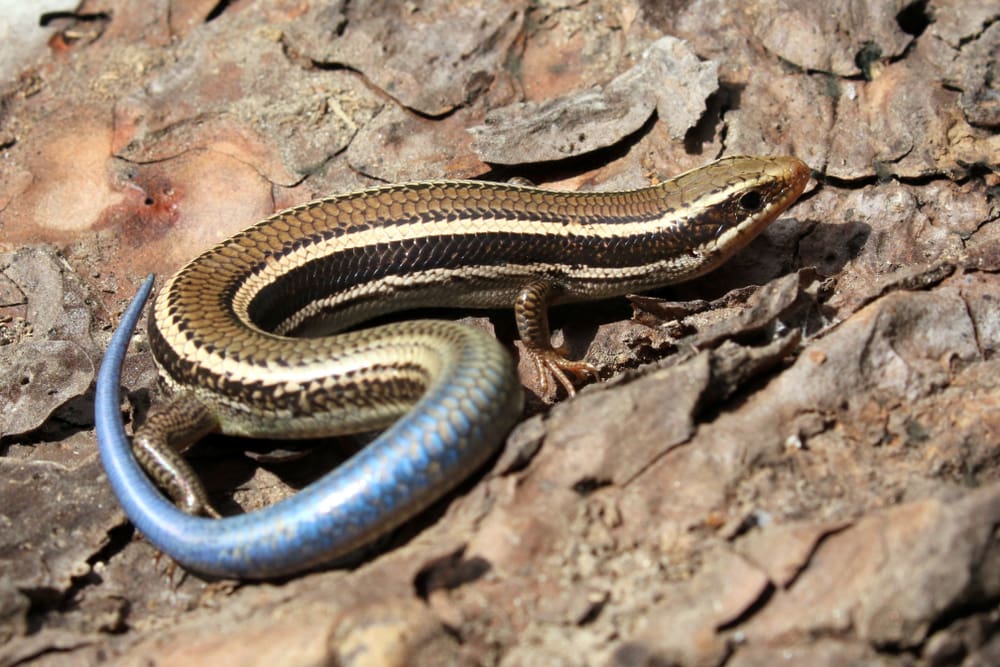
The Western Skinks are part of the P. Skiltonianus species. Found in Northern California, though the largest population is in Central and Southern California. This species is common in early successional areas.
They grow to about 2.1 to 3.4 inches (3-8 cm) and have 10 years of life expectancy.
They are small-headed, thick-necked, small-bodied, small-legged, and have smooth cycloid scales.
The lizards have a dark brown strip and back edges next to white ones on the side. The stripes run from their noses to the base of the tails. Adult lizards have a blue hue that is hard to miss. It also turns red-orange on the underpart during mating seasons.
One interesting fact about the Western Skinks is that they have 7 supralabial scales on the upper lip of their mouths.
This is also one of the few species that guard their eggs once the females lay them.
They sever their tails, also called autotomy, and grow them back when under threat.
There are three subspecies of the Western Skink:
- The Skilton’s Skink
- The Great Basin Skink
- Coronado Skink
Western Skinks feed on insects and spiders. They were preyed upon by raccoons, snakes, foxes, and birds.
24. Granite Spiny Lizard
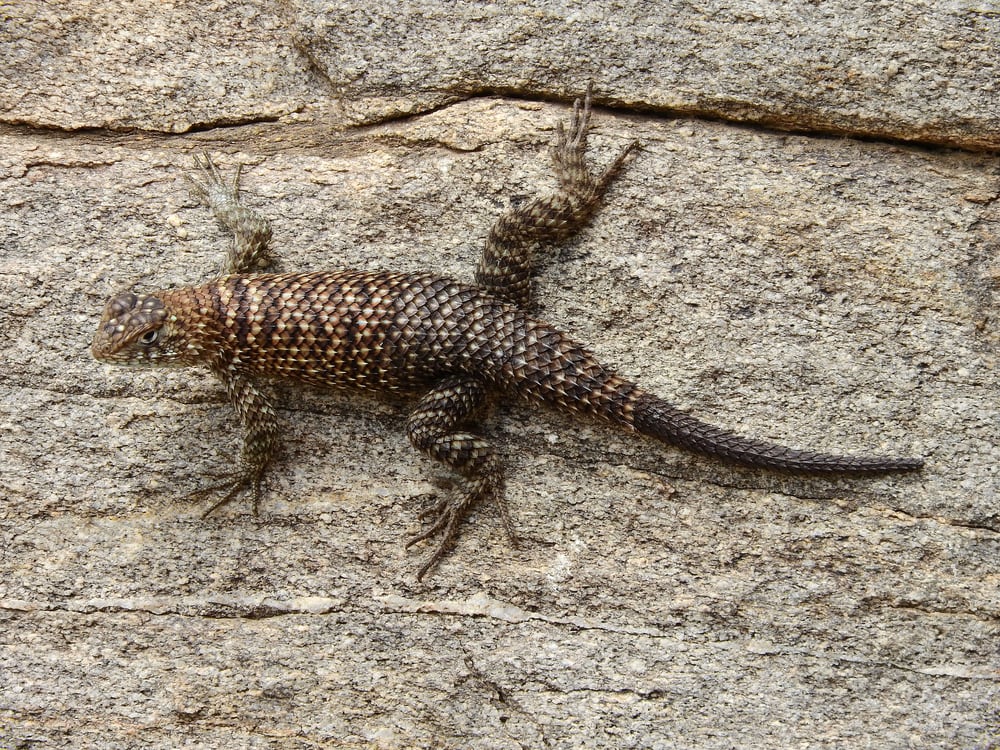
The Granite Spiny lizard is part of the S. Woodi species. Found North of the San Gorgonio pass in California. They are also spotted in parts of Baja, California.
They grow to about 3.25 to 4.5 inches (8-10cm) and live for up to 4 years. Not the longest in the lizard community, but they have a decent life span.
Granite Spiny lizards are big and have large pointy overlapping scales that look like armor. The scales at the ends of their tails are keeled and have a sharp tip-looking appearance that adds to their mystic.
They are multi-colored and one of the most magnificent lizards to lay your eyes on. The scales have a bluish-greenish hue in the middle, contrasted by a dark background. The effect they give is almost holographic. The bellies on the males are blue and a sight to see.
They are also swift and difficult to catch. They bite when held. Like other lizards they can lose their tails and grow a new one.
25. California Legless Lizard
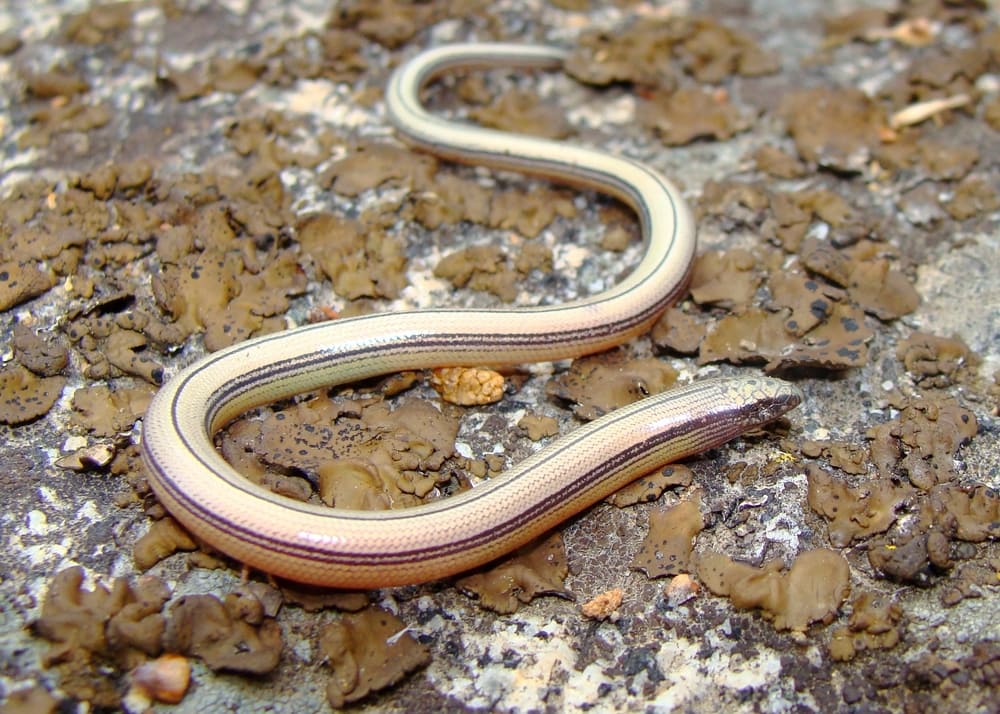
The California Legless lizard is part of the Anniella Pulchra species. Found in the coastal dunes, valley foot-hills, and chaparral shrubs. However, the largest population is located in the sandy Contra Costa County. Suggesting that they like looser sand for their habitat.
They grow to about 4.5 to 7 inches (11-17cm) and have a 20-years life expectancy. Not too bad for these down-to-earth creatures.
The California Legless lizard has a long slender body, smooth scales, and the thing that makes a lizard and not a snake, eyelids. They also have a fixed jaw and don’t have a forked tongue to differentiate them from snakes further. But like snakes, males in this species of lizards are smaller than females.
They like to burrow in loose sand and spend most of their time in burrows. They emerge at dusk to feed in the nighttime.
They feed on larval insects, beetles, and spiders. Their predators are alligator lizards, snakes, birds, and cats.
26. Great Basin Collared Lizard
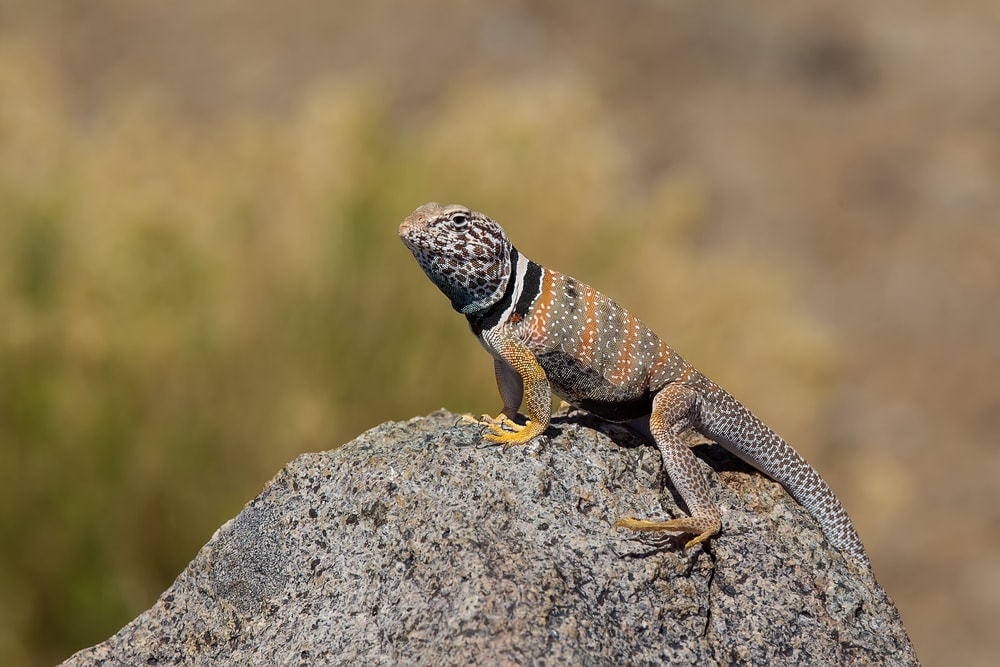
The Great Basin Collared Lizards are part of the C. Bicinctores species. Found in the Northeast part of California in the Great Basin, the Mojave desert, and the Northern and Eastern sides of the Imperial Valley.
They grow to about 3.5 to 4.5 inches (9-11cm) and have five to eight years of life expectancy.
The Great Basin Collared lizards have a large head attached to their broad bodies by a slender neck. They have large limbs and long thick tails.
They have a grey hue dotted with white spots on their bodies. They have two distinctive black bands/collars split by a white one on their necks.
The black bands are more pronounced on males than females and generally have brighter colors. However, females develop red-orange stripes on their bodies and necks during the breeding seasons.
An interesting fact about this species is that young males pose like pregnant females to avoid fighting with older males since Great Basin Collared males become very aggressive during the breeding season.
They feed on leaves, flowers, insects, spiders, and smaller lizards. Their natural predators are foxes, snakes, and birds.
27. Barefoot Gecko
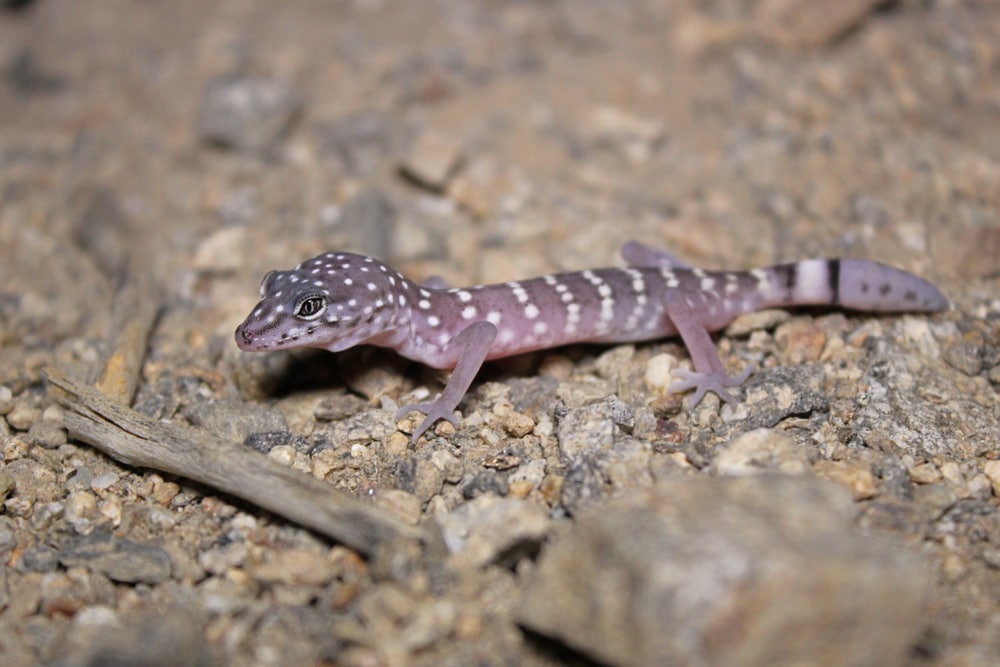
The Barefoot Geckos are part of the C. Switaki species. Found in Southern California. They are only present in a handful of counties, such as San Diego and Western imperial County.
They grow to about 2 to 3.5 inches (3-8cm) and have 5-8 years of lifespan. They are also the largest California native geckos.
The barefoot Gecko has a triangular head that is larger than its body, small limbs, and a short tail that is flat at the base. Its pupils are vertical, and it has eyelids.
It has granular scales and soft skin that is reddish-brown with spots.
They are nocturnal and like to spend their time on rocks and boulders, where they tend to hide. It’s a privilege to encounter one during the day.
If you’re lucky enough to encounter and hold one, you will also get to hear it squeak. But if it spots you trying to approach it, you’re more likely to see itcurl its tail and walk away from you as it waves.
28. Mediterranean House Gecko
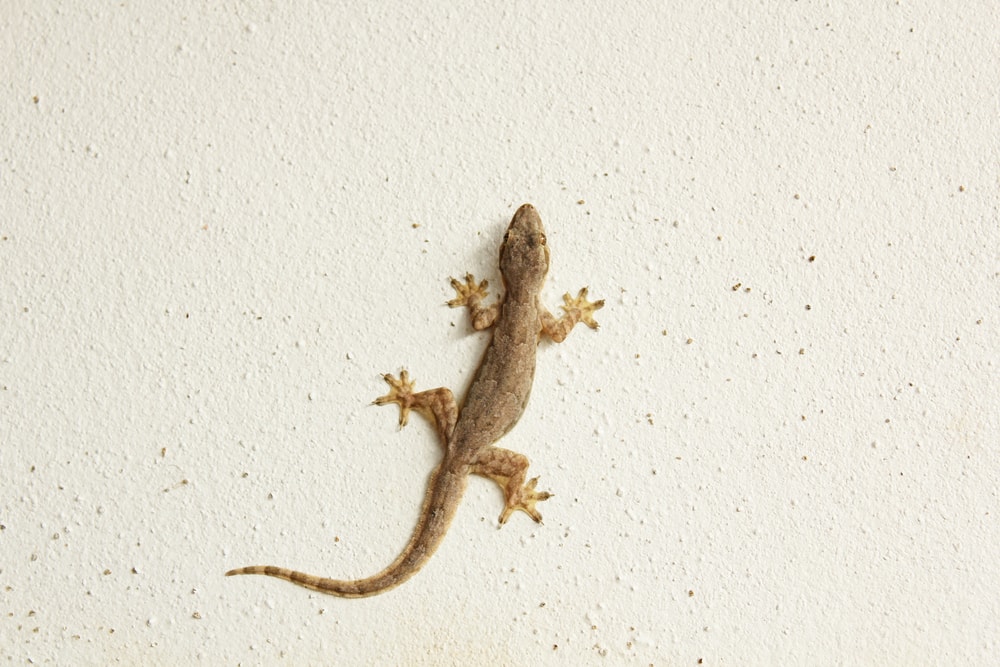
The Mediterranean House Geckos are part of the H. Turcicus species. Found in the Southeast and Los Angeles, California. As their name would suggest, they are not native to California.
They grow to about 1.5 to 2.5 inches (3-6cm) and have 3-9 years of life expectancy.
Mediterranean House Geckos are small and delicate looking. They have flattened bodies with protruding tubercles on their skins. In addition, they have large vertical pupils and don’t possess eyelids, but because they have four small limbs, we can safely say they’re not snakes.
The lizards’ bodies are a pinkish translucent color in their light phase and a darkish greyish color when in the dark phase.
Males make squeaking noises during a fight and to attract mates during the mating season.
The Mediterranean House Geckos like to sit still under a light source at night and wait for insects attracted to the light.
29. Northern Alligator Lizard
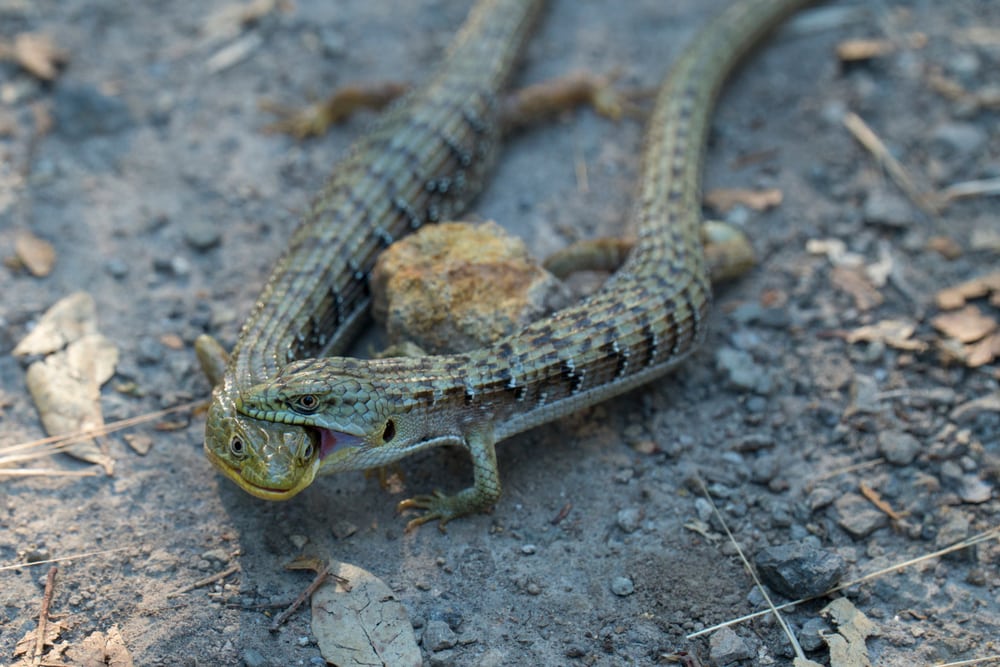
The Northern Alligator lizards are part of the E. Coerulea species. Found in Monterey Bay in the North and Sierra. Their habitats are oak woodlands, chaparral, and grasslands.
They grow to about 2.75 to 5.5 inches (7-14cm) and have a 10-year lifespan.
The Northern Alligator lizards have slender bodies, short limbs, and long tails. Their scales are large and bony and keeled on the back. An interesting fact about the lizards is that they have 16 rows of scales on their backs.
They are brown, grey, or olive with dark crossbands and a middle band in some cases. The Northern Alligator lizard has four subspecies, and all vary in appearance. The four are:
- San Francisco Alligator Lizard
- Shasta Alligator lizard
- Northwestern Alligator Lizard
- Sierra Alligator Lizard
They are active during the day and move with a snake-like angulation. The species also break their tails off as they escape predators and grow them back.
Unlike most lizards and reptiles, female Northern Alligator lizards give birth to their young ones—as many as 15 at a time.
30. Panamint Alligator Lizard
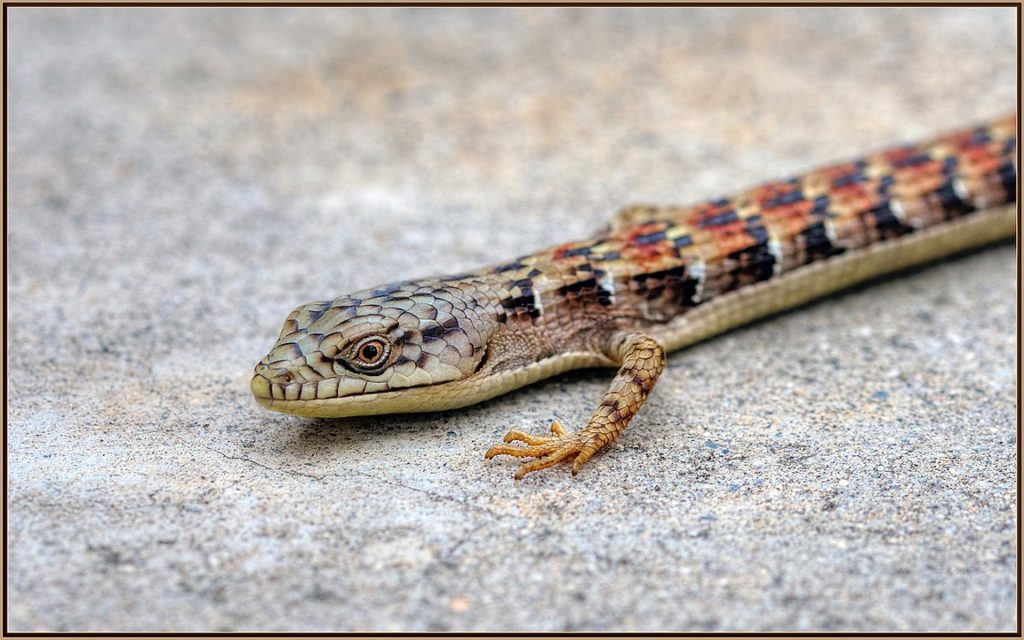
The Panamint Alligator lizards are part of the E. Panamintina species and endemic to California. They are found in elevations between 2,500 to 7,513 feet in Inyo and Mono Counties.
They grow to about 3.5 to 6 inches (9-22cm) and have 15 years of life expectancy.
The Panamint Alligator lizards have long bodies, large heads, and strong jaws like their larger namesakes. They have a yellow or beige hue with stripes running down their body. There are white marks on the sides of the strips that are distinctive to this species.
Their underbellies are cream-colored, and the tails are banded.
Panamint Alligator lizards because they are elusive and prefer damp habitats with a lot of vegetation they can hide in.
31. Long-Tailed Brush Lizard
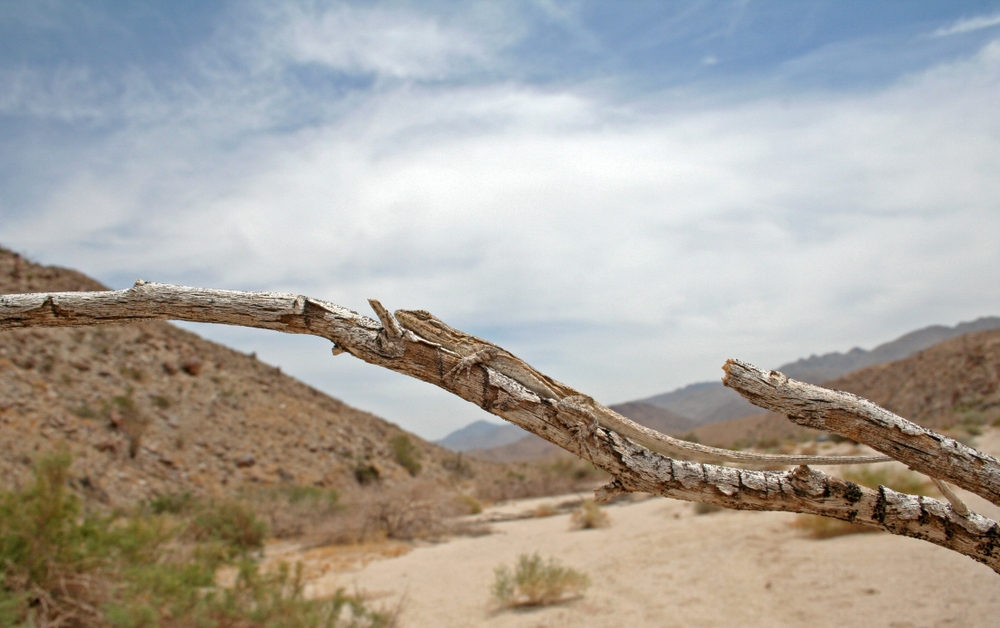
The long-Tailed Brush lizard is part of the U. Gracious species. Located in the Southeastern deserts of California, you will most likely find it hanging out on a creosote bush.
It grows to about 1.9 to 2.75 inches (2-7cm) and has a 6-year life expectancy.
As their name suggests, the Long-Tailed Brush lizards are defined by their long tails that grow twice as long as their body size.
The lizards have a long slender body and a tiny head. They have a mixture of small and large granular and keeled scales. And a band of large scales that run down their backs from the back of their heads.
They are grey with black blotches but can change color to a pale tan if captured. They have a yellow, red, or orange throat, but the males are identifiable by the blue patches on the sides of their stomachs.
Their camouflage loosely resembles the barks of trees, allowing them to blend well with their surroundings and be hard to spot.
The species is active from March through fall, and it’s diurnal.
32. Island Night Lizard
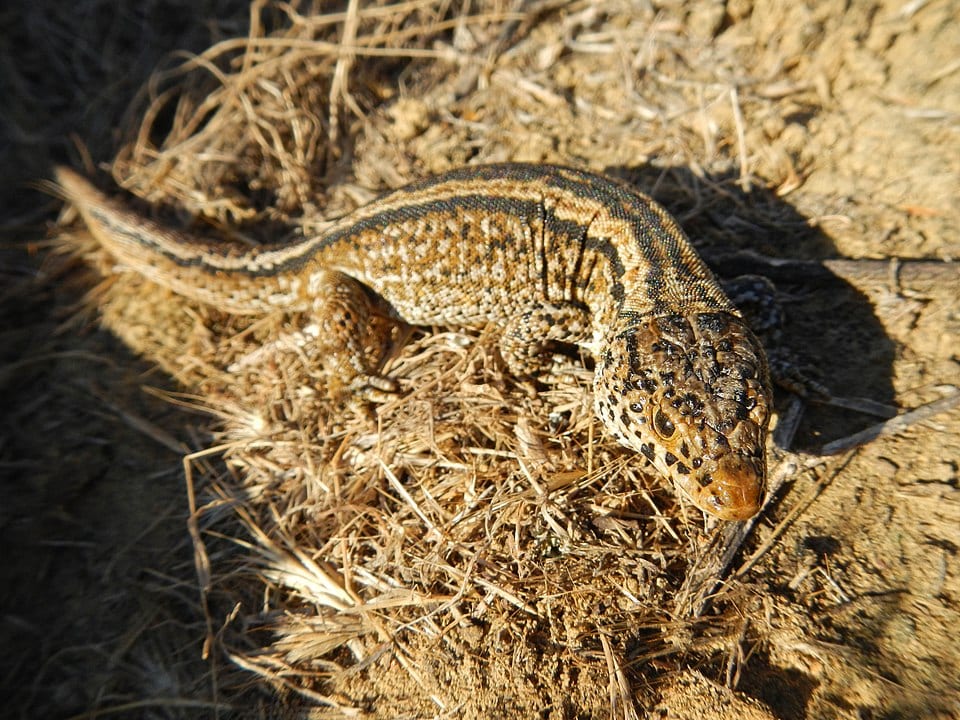
The Island Night lizards are part of the X. Riversiana species. Endemic to the Californian islands of Santa Barbra, San Nicolas, and San Clemente.
They grow to about 2.5 to 4.2 inches (6-10cm) and have 25 years of life expectancy. We guess there is something good about living on an island.
The Island Night lizards are average-sized and have squashy skin containing granular scales. Their skin is also loose and sags and folds a bit on their necks, shoulders, and the sides of their bodies.
The species does not have eyelids, and their pupils are vertical. They range in hues from brown-grey to yellowish-brown with dark brown or balk blotches. Their underbellies are slate blue, cream or yellow.
Unlike their name would suggest, Island Night lizards are diurnal, and ironically enough, they are most active at midday.
The species also gives birth to its young ones and does not lay eggs.
Their metabolism is low and only requires about half the food other similarly sized lizards would require reducing their energy needs even further.
Their tails break off and grow back when startled.
33. Orange-Throated Whiptail
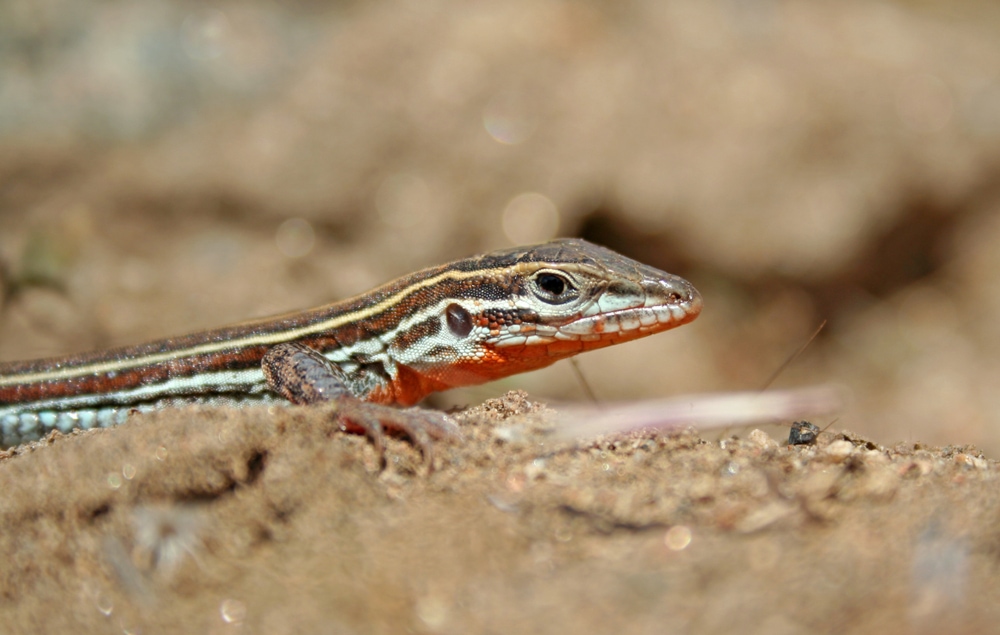
The Orange-Throated Whiptail is part of the A. hyperythrus species. Found in the Santa River in Orange County, San Bernardino County, and the Cape region of the Baja Peninsula.
They grow to about 2 to 2.75 inches (2-6cm) and have 6-8 years of life expectancy.
They have slim bodies and long thin tails. Their pointed snout and symmetrical heads characterize them and have granular scales on their backs and keeled ones on the tails.
They are commonly brown, grey, and unspotted, with six or fewer yellow stripes on their backs. Their throats and chests are orange and become even more pronounced during the mating seasons.
The Orange-Throated Whiptail is diurnal and a very wary creature. It moves fast with abrupt stops to look around and flick its tongue. It can break off and grow its tail when threatened.
34. Desert Night Lizard
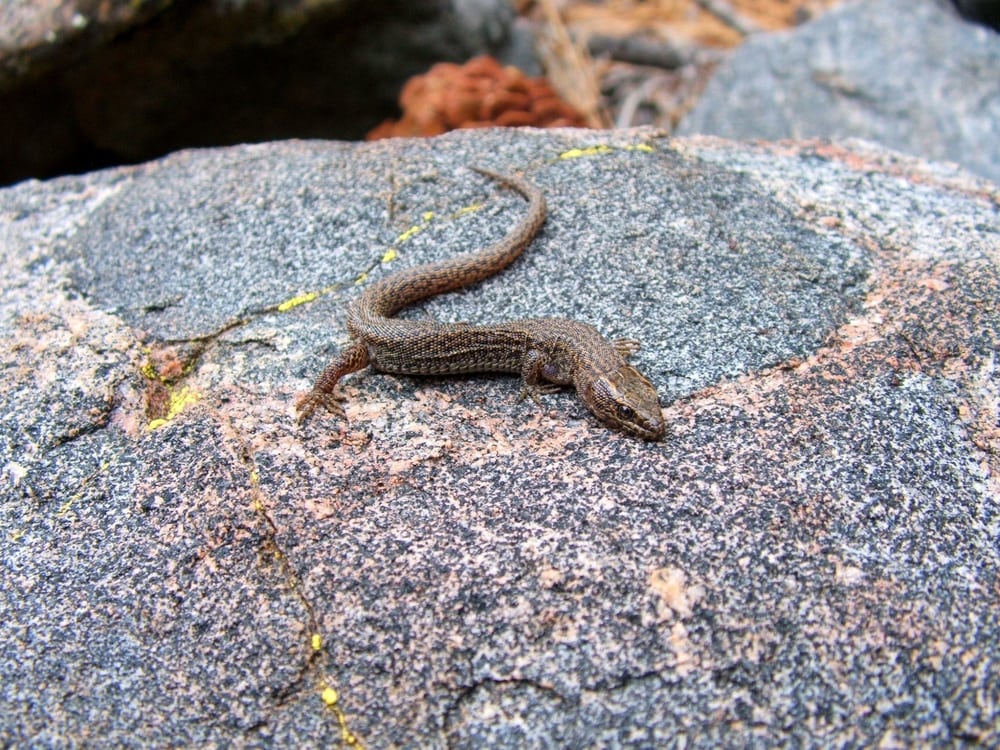
The Desert Night lizards are part of the X. Vigilis species. Found in Southern California, Eastern Sierra, and some portions of Baja.
They grow to about 1.5 to 2.75 inches (3-7cm) and have 20 years of life expectancy.
The Desert Night lizards are petite with velvety soft skin and fin granular scales on their bodies. Their heads are covered with large plates, and they have lidless eyes.
Their color is mostly olive, gray, or dark brown with blotches of dark brown. Their undersides are made up of 12 rowed scales that are a pale white.
The Desert Night lizard is reclusive and likes to keep to itself under dead plants, rocks, or other debris on the desert’s surface.
True to their names, they are active during twilight and even nocturnal during the summer to avoid the heat.
35. Brown Anole
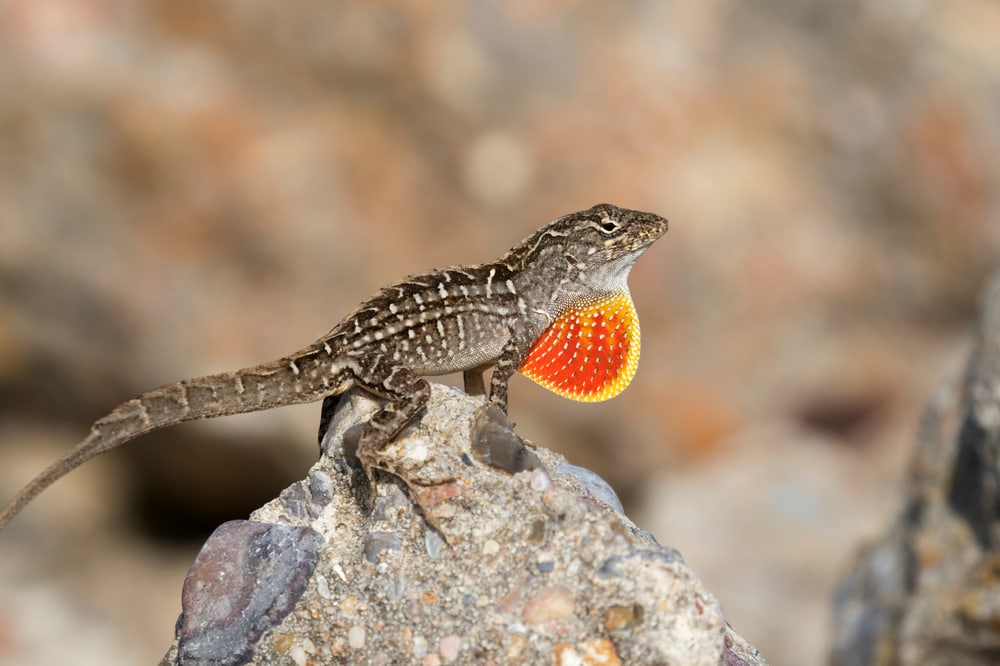
The Brown Anoles are part of the A, Sagri. Found in Southern California, this is an invasive species from Cuba and parts of the Bahamas.
They grow to about 5 to 8.5 inches (12-21cm) and have a 2-year lifespan. That’s good news for California, but the damage they can still do in that short period is substantial.
The Brown Anoles are small lizards with protracted heads, snouts, and long tails.
Male lizards are dark brown or dark grey, and a white stripe is present on their throats. They can also extend their throats to reveal a bright orange sail to attract females.
Females are gray to brown with dark brown with a scalloped pattern edged on their backs. Depending on their surroundings, they can change from a light to a dark brown.
Male Brown Anoles assert their dominance by basking in the sun in higher elevations than females and juveniles. The species are well adapted to urban environments and are even seen foraging at night under the street lights.
36. Italian Wall Lizard
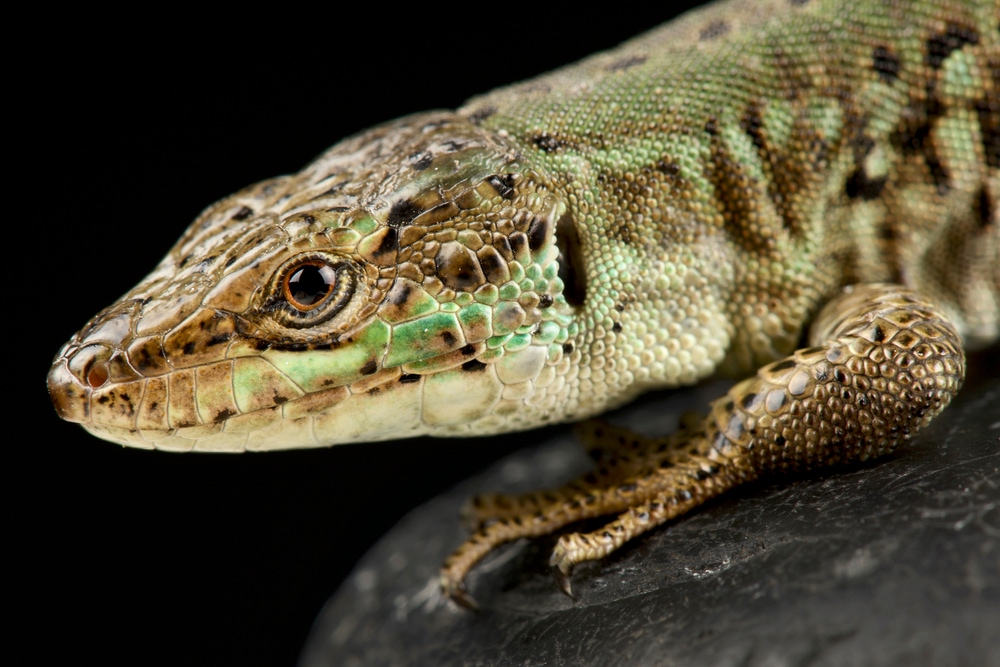
The Italian Wall lizards are part of the P. Siculus species. They are an invasive species found in Los Angeles, California. They were introduced by a homeowner who brought a few back from a trip to Sicily.
They grow to about 3.9 inches (10cm) and have 10-13 years of life expectancy.
They are medium-sized lizards with long thin bodies and tails that can grow to twice the length of their bodies.
They usually have a greenish, yellowish, to light brown hue that is appealing. During the summer months, some even change to a brownish hue.
Their underbodies are white or grey with no marking on them.
The species is diurnal and tolerant of humans. They are excellent climbers and hunt on the ground and high on walls and trees.



